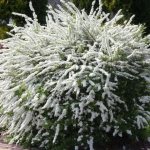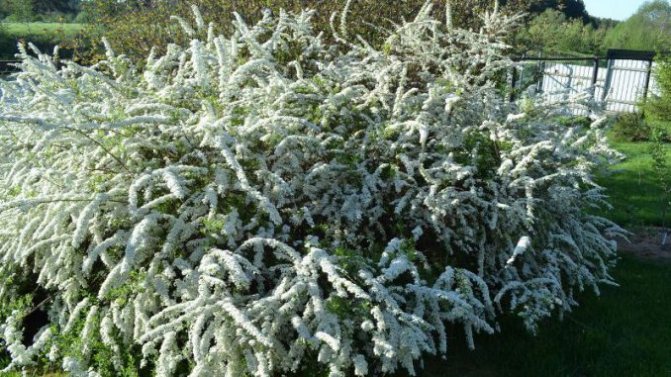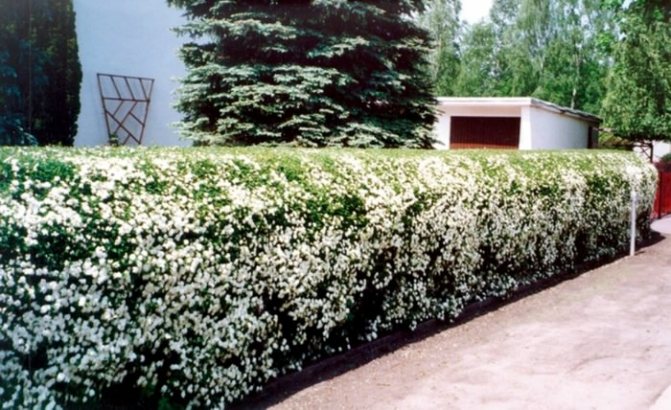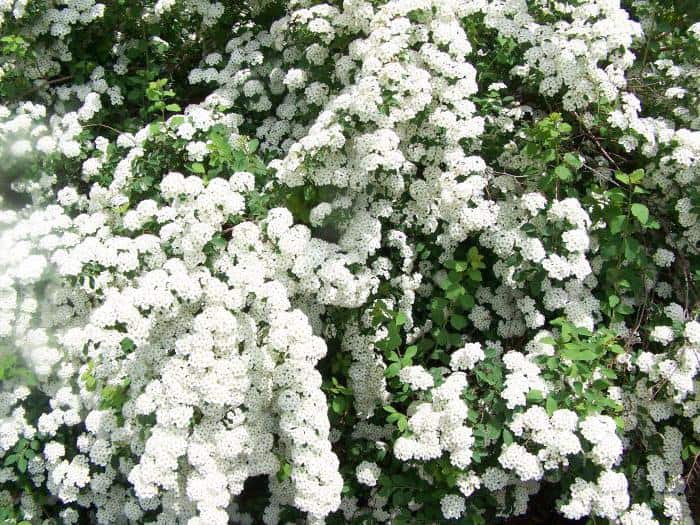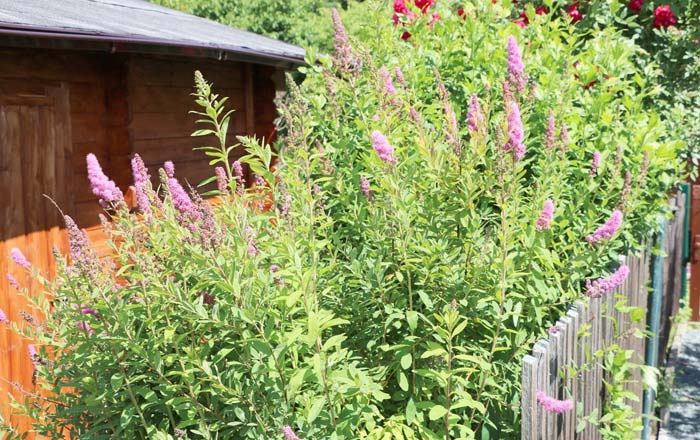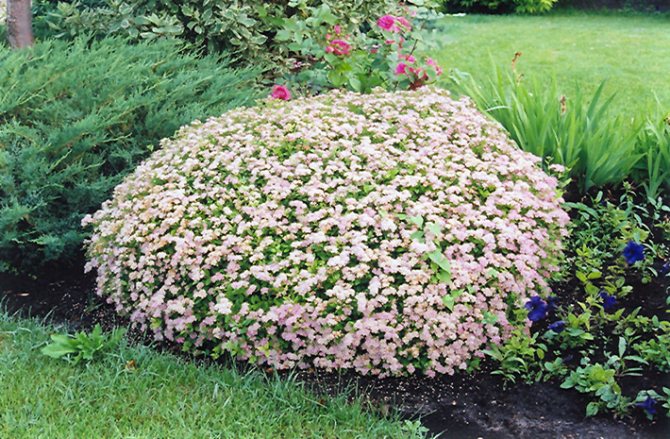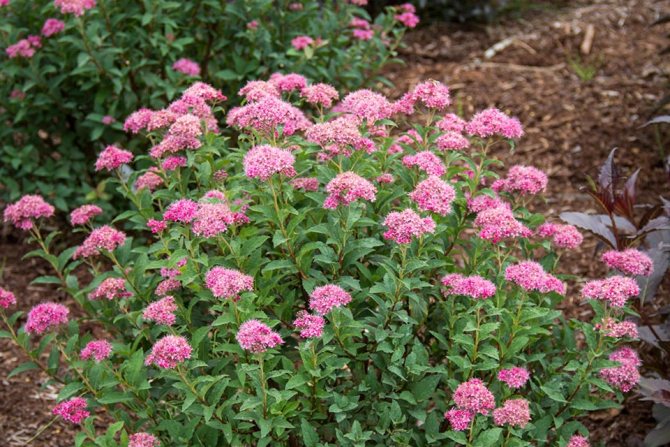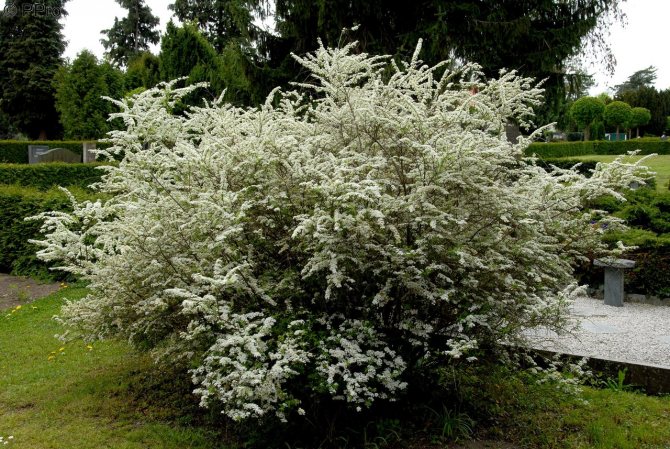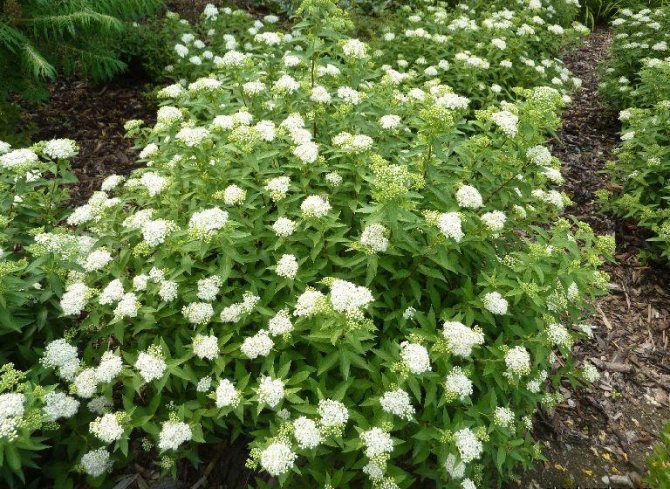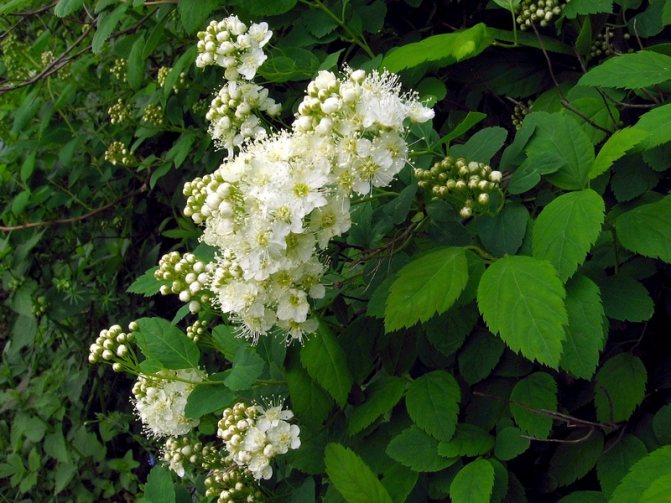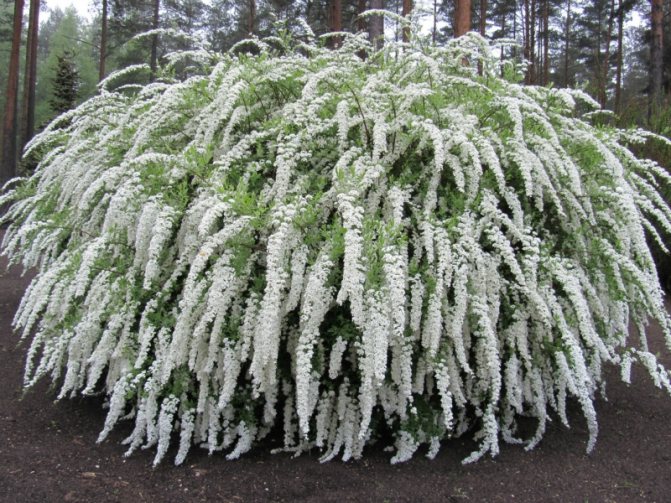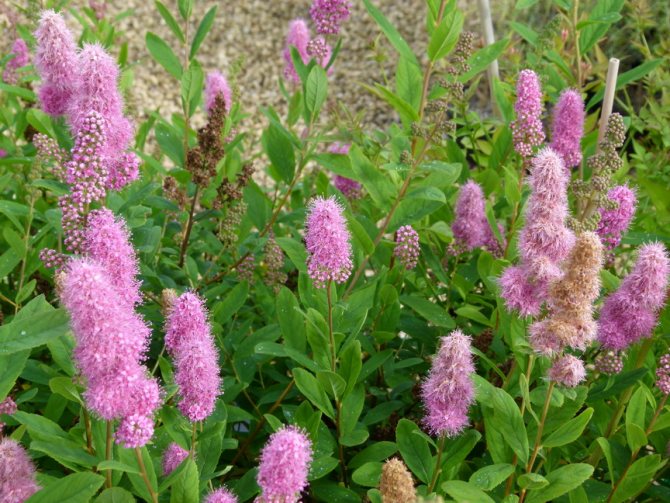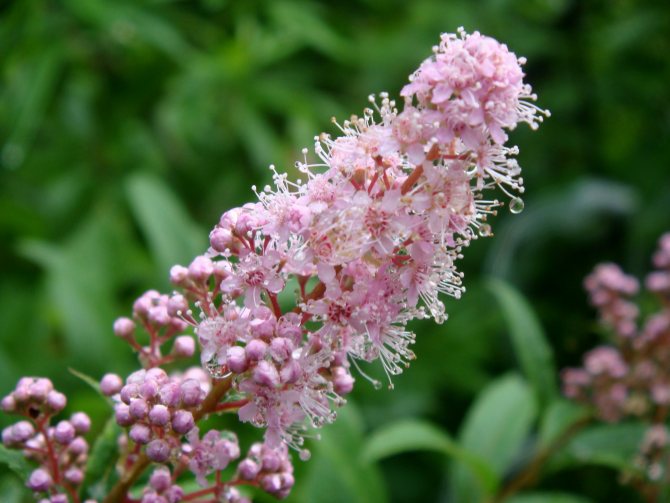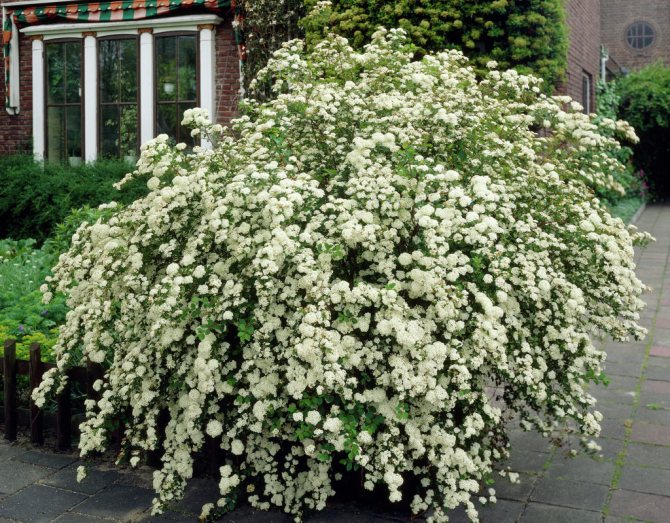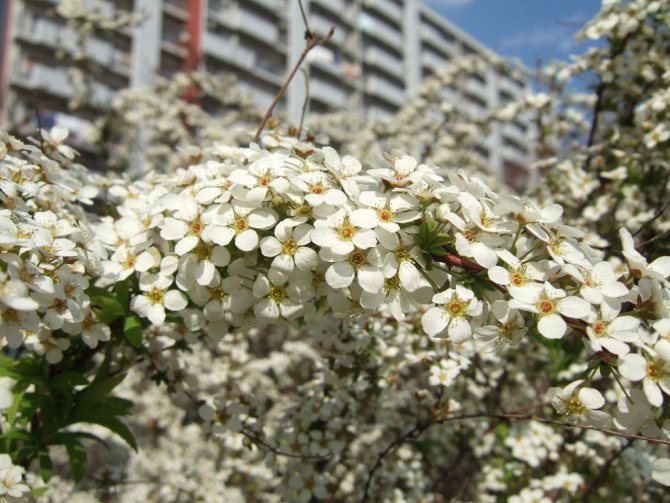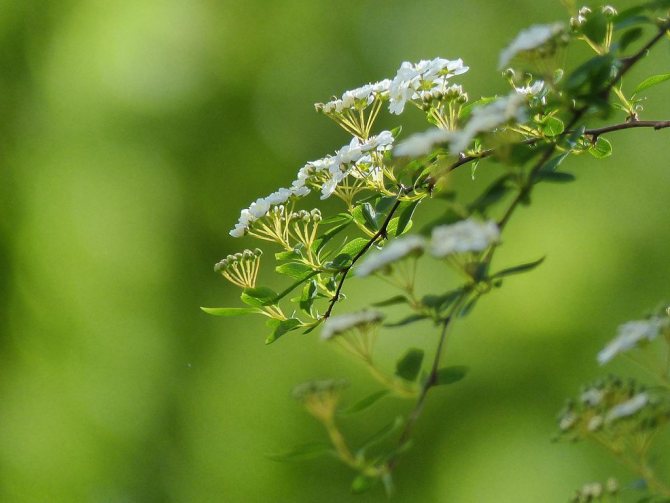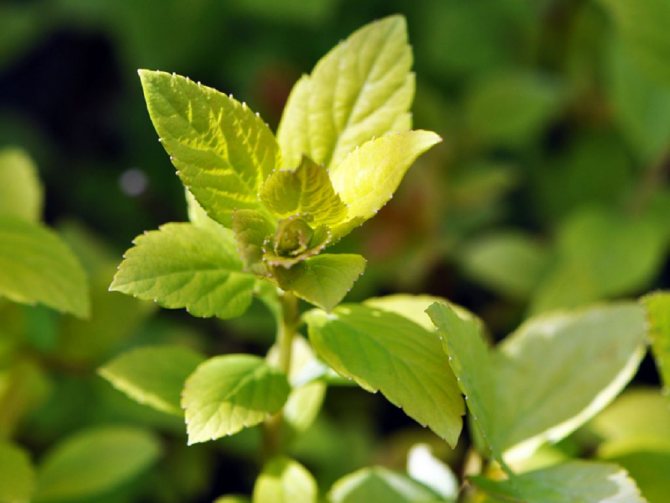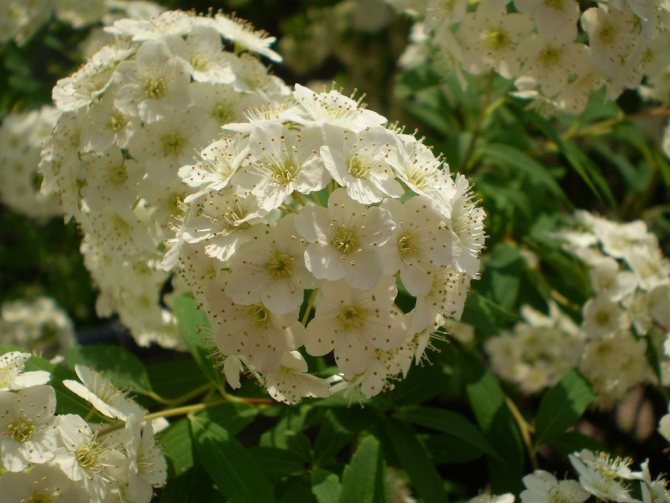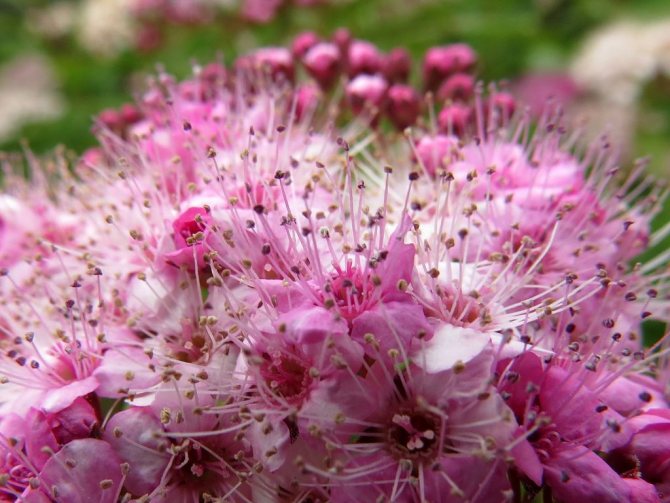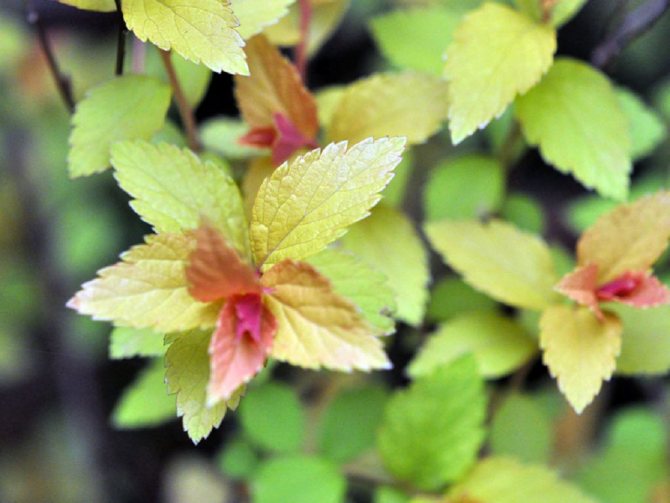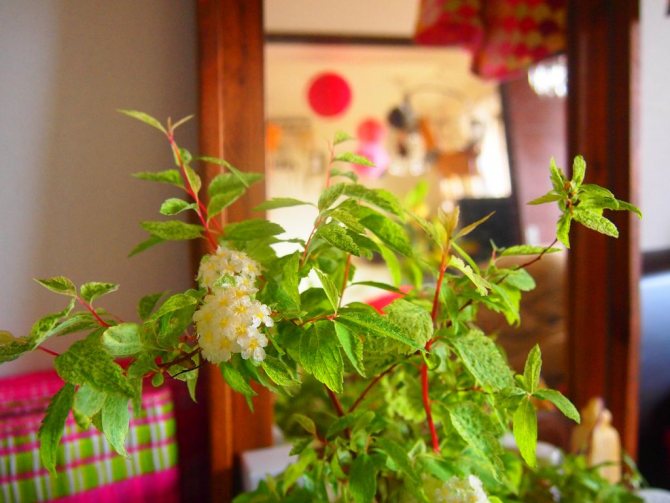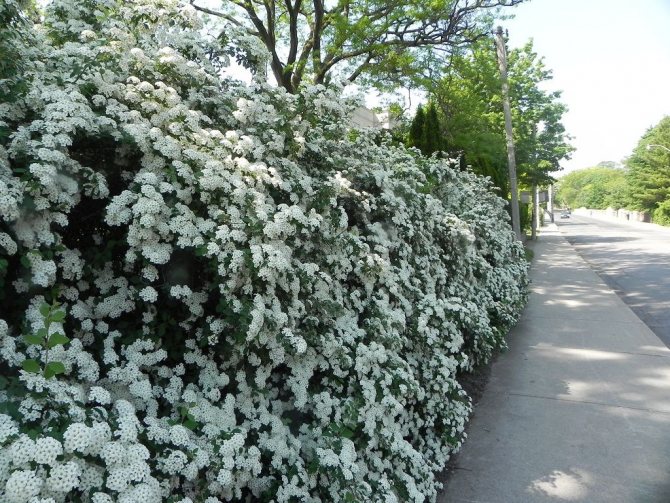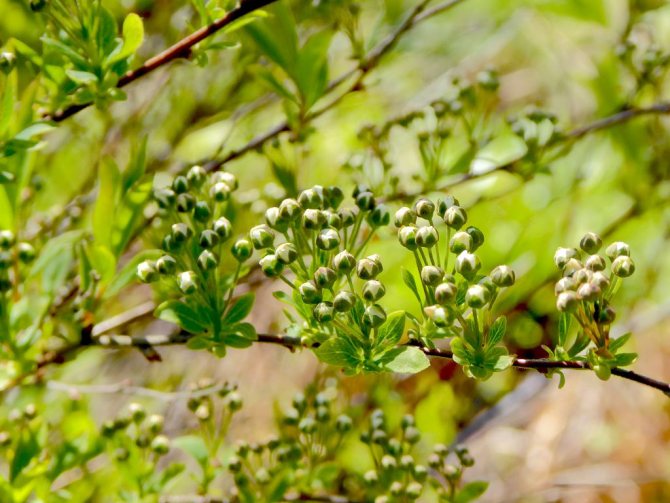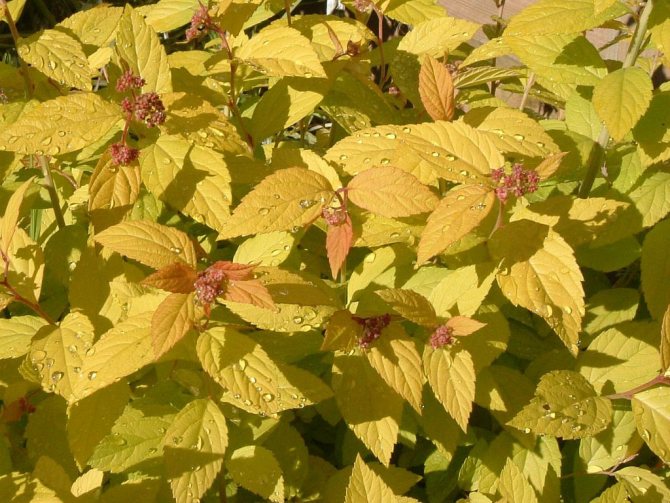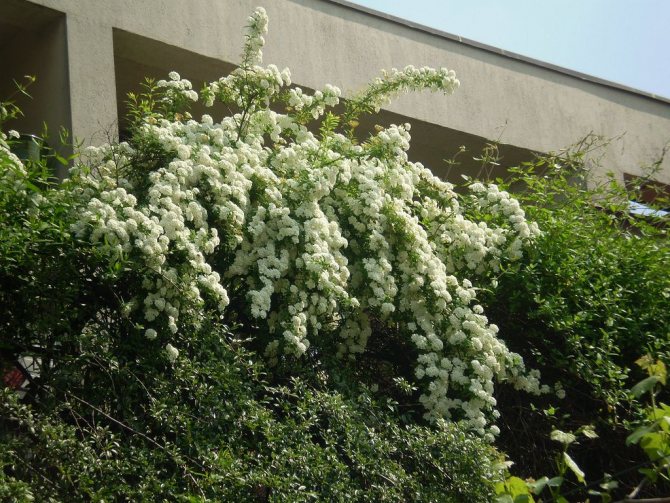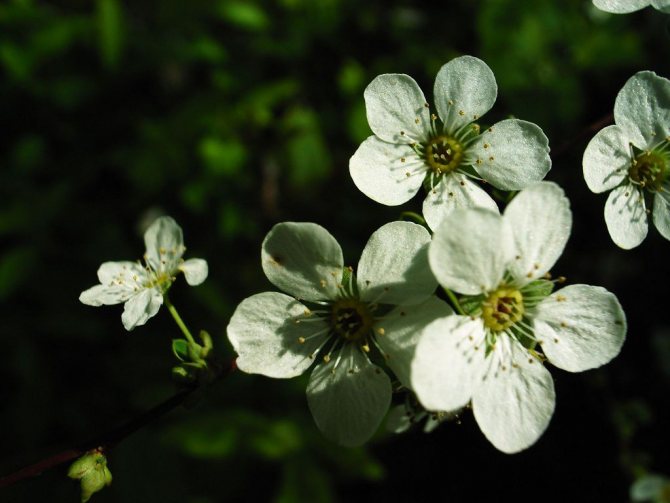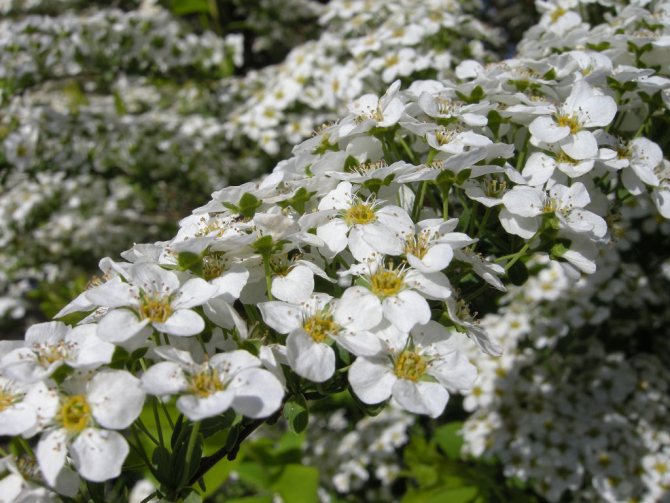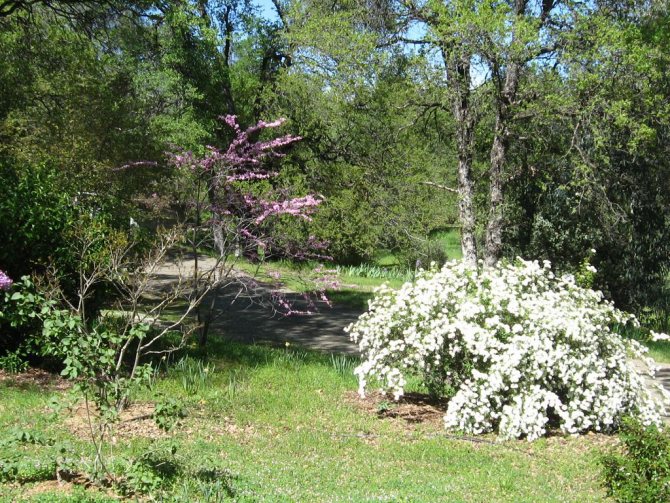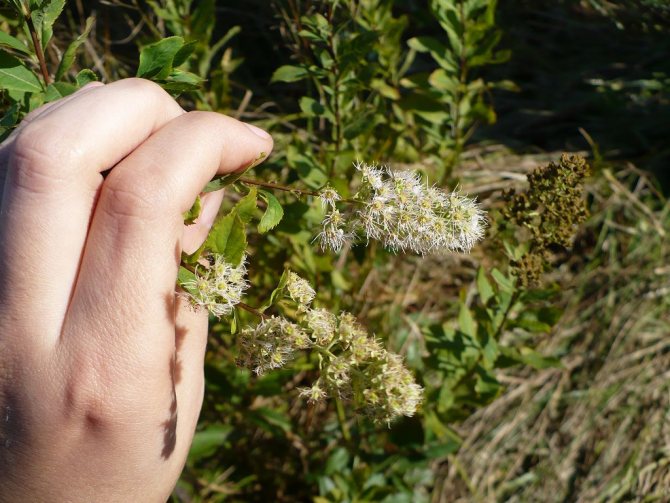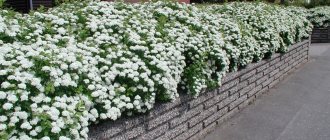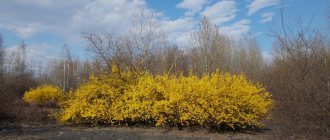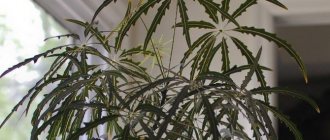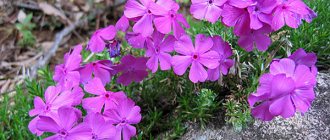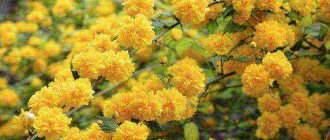Spirea gray Grefsheim is a deciduous shrub belonging to the Rosaceae family. The genus of these plants is quite extensive, without any particular difficulties amenable to interspecific crossing. In the course of the breeding experiment, two varieties were used: Zverobolistnaya and Belovato-gray. Thus, in 1949, a new hybrid species appeared in Norway - Spiraeacinerea Grefsheim.
Due to its extraordinary properties, it is used to decorate household plots, gardens, parks. Landscape designers prefer the Grefsheim hybrid for aesthetics and variability, and gardeners for minimal maintenance.
Description and photo
The spirea plant is a deciduous shrub up to two meters high. The most common are weeping, erect, hemispherical, cascading and creeping forms. Depending on the variety and type, the plant has a different leaf plate, as well as different inflorescences. Spirea flowers are small, but very numerous. The color of the petals ranges from white to crimson. In some species, the inflorescences completely cover the entire bush, while in others they are located only on the upper or lower part of the shoots.
The plant is often used in landscaping because of its beautiful foliage, which in some species changes color during the season, as well as its decorative flowers. The shrub is unpretentious to care for, undemanding to climate and soil. Spirea grows and develops rapidly, but flowering is observed only 3 years after planting.
All types of this shrub are conventionally divided into two groups - spring-flowering and summer-flowering spireas.
Propagation by cuttings
Cutting allows you to get all the distinctive features of the desired variety with a 100% guarantee. The method of propagation of spirea by cuttings is used most often. It will not be a mistake to plant spirea cuttings, both in spring and in summer.
- Spring planting of spirea cuttings;
Cuttings cut from the middle of a lignified shoot should have at least 5 - 6 healthy buds. Planting is carried out either in containers or directly into the ground. Spring planting makes it possible to calmly settle down before the onset of stable cold weather. The rooted shoot enters a state of rest not weakened.
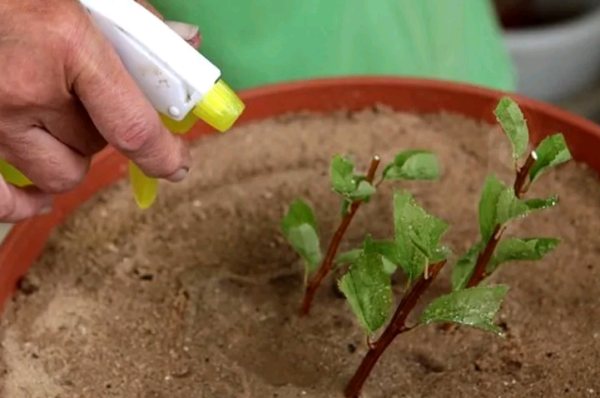
- Autumn planting of cuttings;
The optimal time for this operation is October. The method is considered the least labor-intensive.
- Features of summer planting.
Held in the second half of summer.
Cuttings, pre-harvested from young annual shoots, are soaked in any growth stimulator (to ensure rooting).
The middle part of the shoot is taken. The three lower leaf plates are removed by breaking out together with the petiole. Most of the remaining two upper leaves are removed, leaving a piece at the base.
Planted to a depth of at least 2 cm, be sure to take into account the angle of inclination - up to 45 °. It is believed that this contributes to better rooting.
It should be remembered that:
- Rooting takes at least a month;
- You should choose a place for planting in partial shade;
- It is necessary to observe the humidity regime. This is achieved by spraying.
Spring flowering species and varieties
This group blooms from late spring or early summer. The buds are located on last year's branches, which is important to consider when pruning a bush.Consider the spring variety of spirea.
Spirea gray
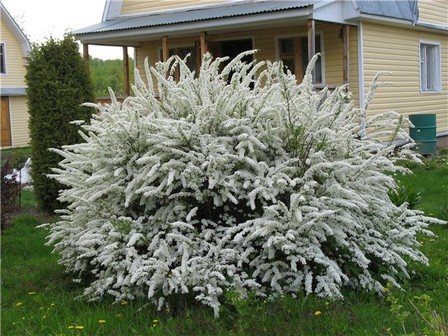

The bush reaches a height of up to 2 meters, has highly branched shoots with pronounced tomentose pubescence. The leaves are colored gray-green, but the shade is lighter on the side. Small and numerous flowers are collected in small inflorescences located throughout the bush. Flowering is observed in May, fruits ripen by June.
This is a hybrid species that does not propagate by seeds; the plant is planted with young bushes, usually in small groups. Blooming shoots can be used to decorate bouquets.
The most interesting variety is Grafsheim. It has good winter hardiness, so it can be grown in cold regions.
Nippon
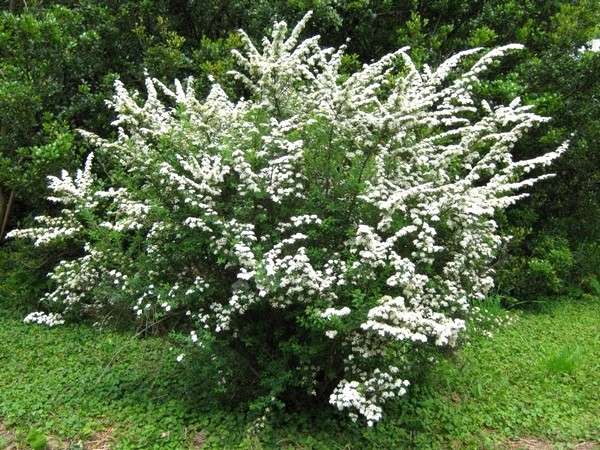

Originally from Japan, where it is commonly used to decorate the garden. The shrub reaches 2 meters in height, has a spherical shape. Long leaves of green color, can retain color until late autumn.
Flowering begins in late May with a duration of up to 25 days. The flowers are yellow-green in color and are collected in corymbose inflorescences, abundantly located along the entire length of the shoots. More often this type of spirea is used for single plantings. In Europe, two varieties are popular - Snowmand and Halvard Silver. They are compact and easy to care for.
Dubravkolistnaya
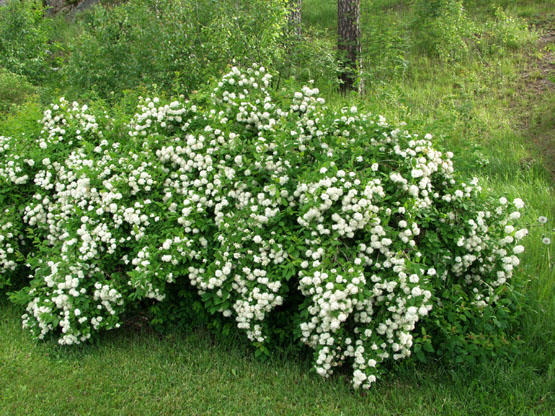

It is found throughout Europe, where the shrub is often used to decorate hedges. Spirea is represented by an erect shrub up to 2 meters in height. The shoots are often pressed to the ground under the weight of heavy inflorescences, so regular pruning is required. The leaves are pointed, the plate is green on top, gray on the bottom.
The color is small (up to 1.5 cm in diameter), collected in spherical white inflorescences. Flowering begins in mid-May, lasts up to 25-30 days. Grows rapidly, seed propagation is possible.
Spirea Argut
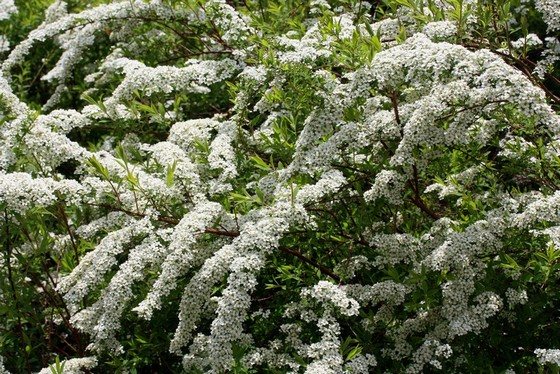

Slow growing plant, which is often used in decorative compositions with other perennials. Prefers light and dry places, which is important to consider when planting. Even in favorable conditions, it grows very slowly.
A distinctive feature of this species is the spreading crown, abundantly covering the entire bush. The leaves are strongly serrated and have a rich dark green color. The flowers are deep white in color, collected in umbrella-shaped inflorescences. Flowering begins in late spring, can last up to 30 days, pruning can only be done after the petals fall.
Gorodchaty
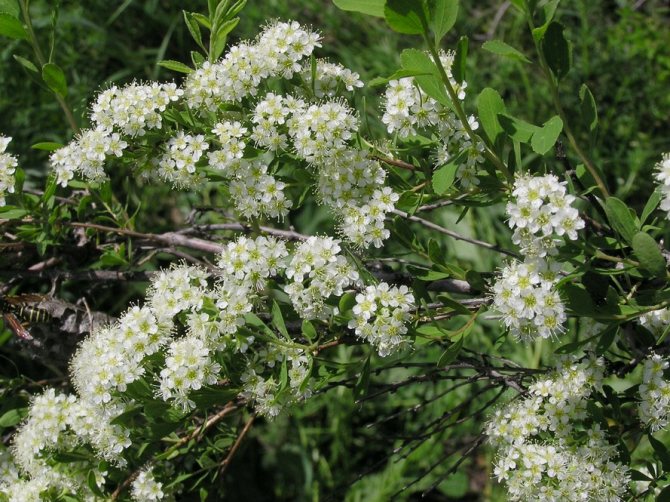

It can be found everywhere on the meadow and shrub steppes of Russia, the Caucasus and Central Asia. Prefers to grow in higher elevations.
It is a short shrub, rarely exceeding 1 meter in height. Has a loose green crown, collected from elongated gray-green leaves. It got its name for the crenellated edge of the leaf plate.
The flowers are white with a slight yellow tinge. Inflorescences are corymbose, located on short branches. The duration of flowering is only up to 20 days; it enters the fruiting stage from mid-July.
The crenate spirea has a highly developed root system, so it is recommended to plant it away from the beds with cultivated plants. It is this species that can often be found in city parks and forest plantations.
Spirea Thunberg
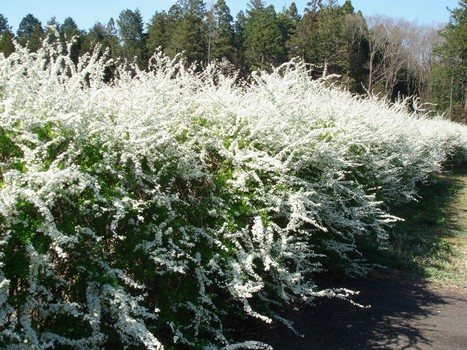

Under natural conditions, it grows in eastern countries - Japan, China and Korea. It looks especially beautiful on small hills, so it is often used to decorate alpine slides.
In a garden, the bush reaches a size of 1-1.5 meters, branches abundantly. On the shoots there are dense and small leaves, which acquire a golden hue in autumn. Inflorescences are represented by sessile umbrellas, consisting of small white flowers.
Flowering begins in May and flesh continues until the end of June. This type of spirea prefers well-lit places and does not tolerate low temperatures well, therefore, in cold regions, it is recommended to cover the bush for the winter.
Spirea Wangutta
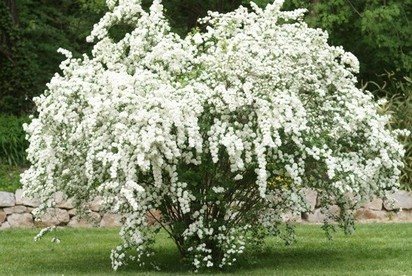

The plant is represented by a powerful and tall bush that reaches a height of up to 2 meters. It differs from other species in an interesting cascading crown shape, consisting of many small green leaves, obovate.
Flowers of deep white color are collected in hemispherical inflorescences that cover almost the entire length of the shoots. Flowering begins in late May and lasts up to 2-3 weeks. Secondary and less abundant flowering is sometimes observed, which occurs at the end of August. This is a shade-tolerant and not whimsical plant that can be used for single or multi-species plantings. Best combined with shrubs and coniferous trees.
III. Planting and breeding
Spirea Grefsheim is planted in the fall, when the foliage completely falls, or in the spring - until the buds have blossomed. When decorating a hedge, you should maintain a half-meter distance between the bushes. The row spacing should be at least 40 cm.When a group planting meadowsweet, a meter distance is left between the bushes. The diameter of the planting hole should be one third larger than the volume of the root system. The optimal pit depth (taking into account the drainage layer) is 40-50 cm.
Propagated by gray spirea in three ways:
- seeds;
- cuttings;
- layering.
The signs of offspring of sexual reproduction of hybrids are unpredictable, therefore the Grefsheim spirea is usually propagated vegetatively. When grafting, young shoots are separated from meadowsweet, they are divided into fragments about 10 cm in length and planted in the soil or in prepared containers. By autumn, the cuttings root perfectly. Spirea Grafsheim is propagated by layering in the spring. The extreme branches are bent to the ground, fixed and watered abundantly all summer. In the fall or next spring, the plants are separated.
We will illustrate the process of reproduction of spirea by cuttings:
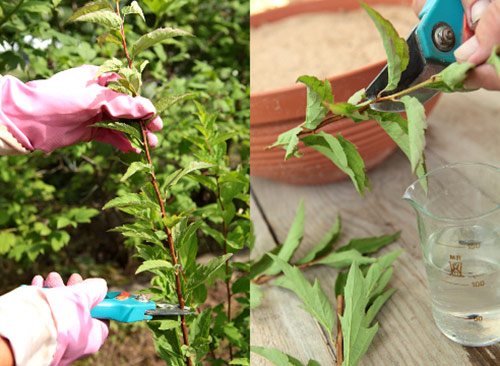

Cutting is the easiest way to propagate Spirea sulfur. Young and mature plant branches are cut with a sharp knife or pruning shears into ten-centimeter pieces (4-5 buds) - cuttings
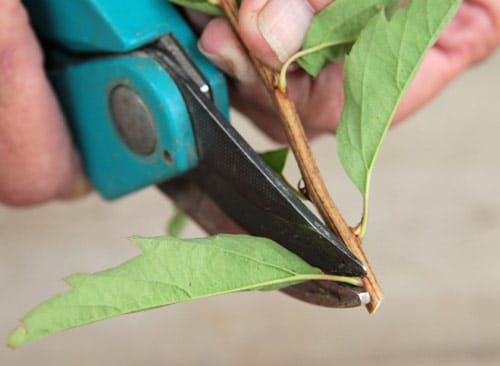

From the bottom of the cutting, the leaves must be cut off at the base.
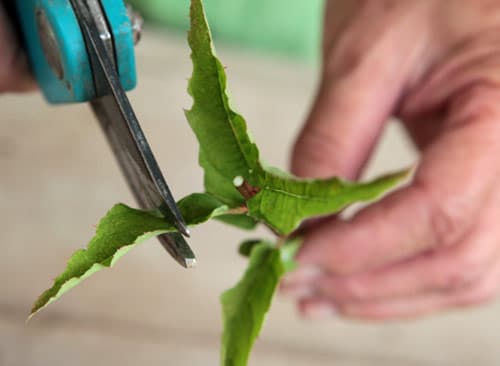

Partially cut off the tops (2/3) from the upper leaves. This method preserves the strength of the cutting for the complex process of rooting.
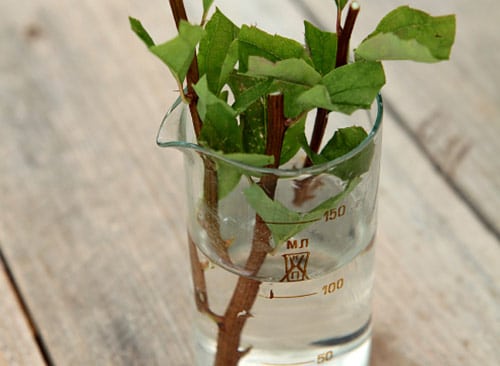

For 12-24 hours, the planting material must be placed in water with Epin dissolved in it (according to the instructions, 2 ml of solution is enough for 1 liter of water)
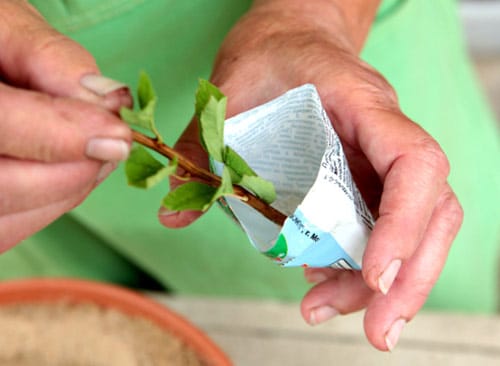

Before planting in the ground (it is better to use moistened river sand), it is advisable to sprinkle the lower part of the cuttings with powder for root formation (Kornevin, Root or others)
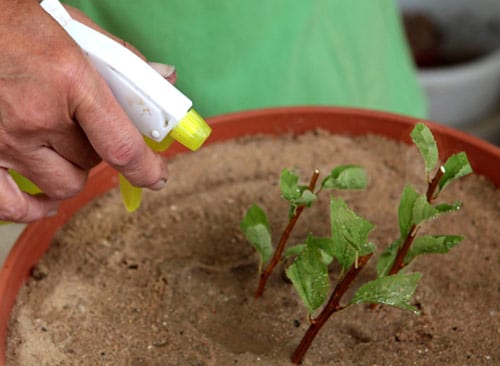

Plant the cuttings correctly at an angle of 45 degrees. The sand in the pot must always be moist.
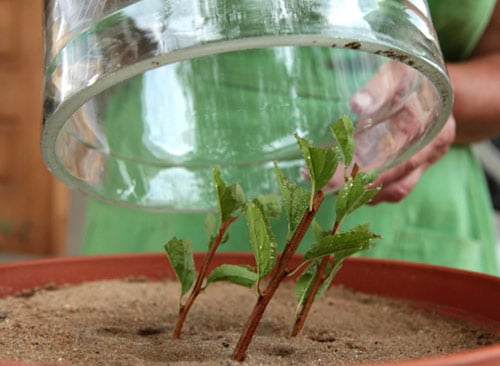

Planted cuttings should be covered with a glass beaker or plastic bag. Periodically, the greenhouse must be ventilated.
Secrets of proper care
Spirea Grefsheim - a plant from the category of "self-growing", does not show any special whims in its care. It is not difficult to take care of it, the requirements are standard - moderate watering, top dressing, pruning, weeding, loosening.
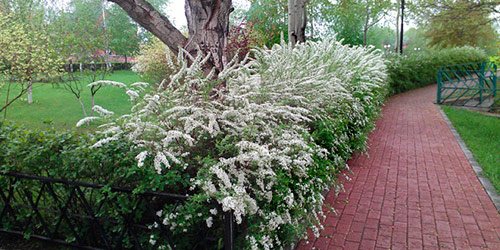

The flowering of spirea pleases the eye up to 1-1.5 months. Abundant flowering is facilitated by correct pruning - old and weak branches are removed
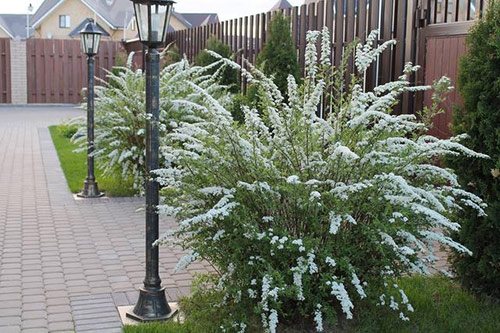

Gray spirea or meadowsweet will decorate a personal plot or garden. Cascades of flowering branches are sure to attract attention and admiration
The life expectancy of spirea Grefsheim is up to 30 years. For rejuvenation, the plant should be pruned periodically. To do this, leave a few strong branches, the rest are removed during the first growing season. For preventive purposes, it is recommended to thin out Grefsheim spirea every two years, cutting off weakened and damaged shoots. To form the crown, pruning is carried out in the first spring months.
Soil care
Spirea Grafsheim roots do not grow very deeply and need soil mulching. To do this, it is enough to cover it with a layer of peat after watering. Water the plant twice a month (one and a half buckets of water). The soil must be loosened to remove weeds. As a top dressing, an infusion of mullein with superphosphate (10 g per bucket of infusion) or complex fertilizer is used. Most of all meadowsweet needs feeding before flowering and after pruning.
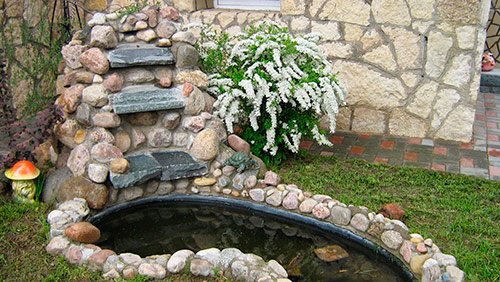

The unpretentiousness of the plant allows you to plant it on various soils and in different conditions: in the sun, in the shady corners of the site or under the crowns of tall trees
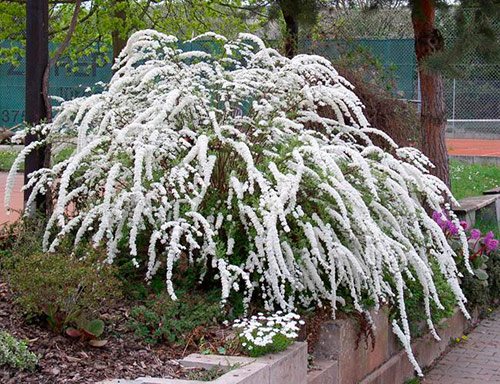

A beautifully flowering plant used in park and landscape gardening. Monoclumba or mixborders with other plants - spirea always looks spectacular
Organization of "wintering"
The shrub tolerates moderate cold easily, but severe frosts can damage the shoots. To avoid this, for the winter they are tied in a bunch, bent to the ground and covered with fallen leaves. To prevent it from blowing out, cut branches are placed on top.
Summer flowering varieties
In this group of spireas, flowers are formed on young shoots. Every year, old shoots dry up, new ones appear to replace them, on which flowers are actively developing. Below are descriptions of the most common types of this group of spirits.
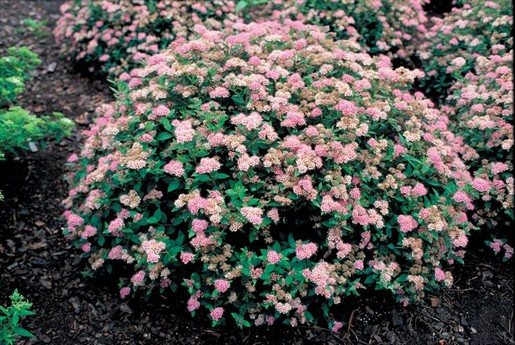

One of the most famous and popular varieties of spirits, which is often used to decorate a Japanese-style garden. It is represented by a compact, almost dwarf bush with abundantly pubescent shoots, which completely throw off their foliage in the fall. It is this type of spirea that is most often depicted in pictures in botanical reference books.
Read also: Pandora Strawberry - variety reviews, description, photo
Flowering in favorable conditions lasts all summer, the average duration is 45 days. Flowers of a red or pink hue, collected in corymbose or paniculate inflorescences. Looks most advantageous in combination with yellow spirea varieties.
The species is represented by a large number of varieties, among which there are shrubs of various shapes, heights and decorativeness. The most popular of them are Shirobana, Macrophylla, Golden Flame, Little Princess.
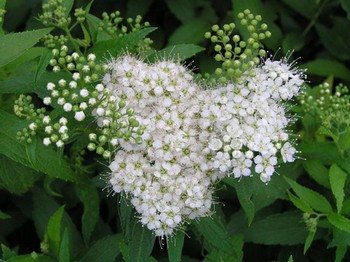

In its natural environment, it is often found in some states of North America. Spirea white is a small shrub with pubescent shoots of a red-brown color. On the branches there are a large number of small serrate leaves up to 7 cm long.
Flowers of a white shade are collected in long paniculate inflorescences with great decorative effect. Flowering lasts from July to late August.
Propagated both by seed and cuttings. It is best suited for creating hedges, but it is often used for single planting as well. Prefers moist soil, which should be considered when choosing a location.
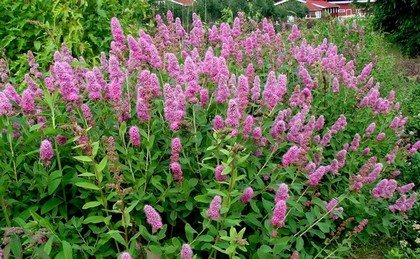

This is a hybrid form, bred by crossing the spirea willow and Douglas. It is ubiquitous throughout Russia, in some southern countries.
The shrub reaches a height of up to 2 meters, the spreading is moderate. On the shoots there are long, double-serrate leaves. Flowers are collected in dense paniculate inflorescences of a red or pink hue. Flowering begins in late July and flesh may continue until frost.
Billard's spirea is one of the most frost-resistant species, propagates exclusively by cuttings. Often used for hedging and pruning. Florists prefer to plant the Triumfans variety, which has the greatest decorative value.
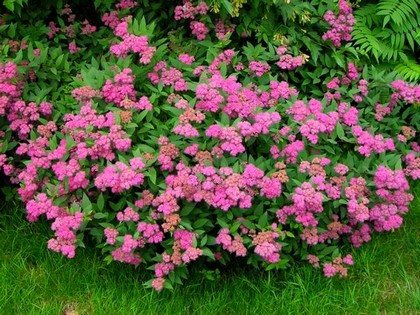

A popular hybrid of white and Japanese spirea. It is represented by a compact and low-growing perennial shrub, up to 75 cm high. The crown is spherical, formed from long lanceolate leaves. Flowers are collected in voluminous inflorescences of red, purple or pink color.Flowering lasts up to 50 days, starting in mid-July. The most popular varieties are Anthony Vaterer, Darts Red, Crispa and Froebel.
Willow
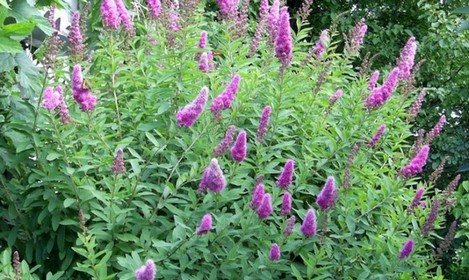

In the wild, it is often found in the central regions of Russia, America and Japan. Willow spirea is a tall upright shrub. On the shoots of red-yellow color there are large sharp-serrated leaves.
Delicate pink or white flowers are collected in a pyramidal panicle that reaches a length of up to 20 cm. Very frost-resistant appearance, suitable for areas with damp and infertile soil. Flowering begins only 4 years after planting, which is important to consider when using willow spirea for group plantings.
Spirea is a popular ornamental plant used in landscape design. Today, a large number of species and varieties have been bred, represented by bushes of various shapes and heights with beautiful small flowers of various colors. The plant develops quickly and is excellent for hedges.
Reproduction of spirea by cuttings in spring and summer
The good news for those who are just about to purchase a spirea is that this beautiful shrub is easily propagated by cuttings. I know for sure that the survival rate is almost 100%, because I repeatedly rooted the branches of my plant in order to get new specimens.
Spirea is an ornamental shrub that, being in bloom, will not leave anyone indifferent. Snow-white fountains of the Wangutta variety, lush caps of Japanese spirea decorate the gardens and fit organically into park ensembles. And in fact, they are the highlight of any landscape.
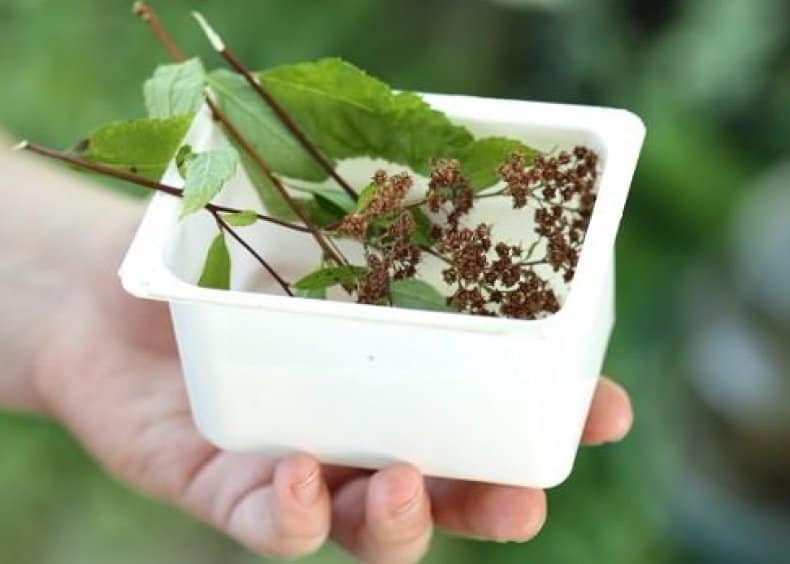

The advantages of this plant include:
- undemanding to soil and care;
- frost resistance;
- good survival rate;
- rapid growth;
- immunity to disease;
- easy reproduction.
The last point includes the seed method and the layering method, dividing the bush and grafting. Most often, gardeners propagate spirea by cuttings, because this is how all the specific characteristics of the plant are preserved. Cut off the branches from the tree you like, and get an exact copy of the mother bush.
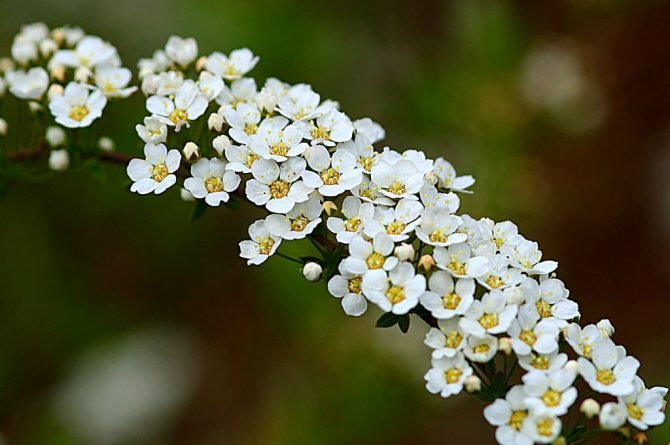

Photos of popular species and varieties of spirea for landscape design
Deciduous shrubs up to two meters high, depending on the variety, can have:
- different crown shape;
- color and type of inflorescences;
- the duration and timing of flowering.
It is not difficult for experienced gardeners to choose plants in such a way that white, pink and crimson spirea flowers serve as a living decoration of the site.
Focusing on the time of mass flowering, the types and varieties of spirea are divided into two groups:
Moreover, in the first case, flower buds are laid on one-year-old branches, while in summer flowering spirits, the buds open on new shoots. With all the differences, these numerous types of ornamental shrubs are unpretentious and after three years they appear on the site in all their glory.
Planting gray spirea
The best time for planting sulfur spirea seedlings is the autumn months, and this work is best done before the leaves fall. In the event that planting is carried out in the spring, then such work should be done before the start of leaf blooming on fruit trees and shrubs. It has been noticed that seedlings that are planted in rainy and cloudy weather take root best of all. It is best to plant spireas in a well-lit place that is protected from the wind.
The depth and diameter of the hole for spirea seedlings should be chosen depending on the size of its root system. On average, the depth and width of the pit for planting seedlings is 50 to 50 centimeters. It is recommended to lay a drainage layer at the bottom, for which you can use chipped bricks or small stones.
Experts recommend digging a hole at least a week before the expected planting date. This will avoid subsequent shedding of the walls and damage to the root system. When planting seedlings, you should moisten dry plant roots, remove damaged and long roots.It is best to fill the seedlings with a special fertile mixture, which is prepared from river sand, peat and sod land in equal parts. The root system should be straightened and carefully covered with prepared fertile soil mixture.
Immediately after planting, the seedlings of ash spirea should be carefully tamped and watered abundantly. Pay attention to the location of the root collar, which should be flush with the ground. In the event that you are planting several seedlings at the same time, the minimum distance between the bushes is 1 meter. It is recommended to mulch the trunk circle with peat or other similar organic materials. The mulch layer should be at least 5 centimeters.
Japanese spirea (Spiraea japonica)


The ancestral home of Japanese spirea is the countries of the Far East, where in 1870 the plant was first cultivated. And since then, dozens of species of varieties of this spirea with pubescent young shoots, elongated and pointed leaves at the end. This type of spirea blooms profusely in summer, giving dense paniculate-corymbose inflorescences.
Shrubs from 1.2 to 2 meters in height, with a neat spherical crown and green or golden foliage are used in the design of borders, in single and group plantings. Due to its winter hardiness, the ability to quickly replenish shoots, even in the case of freezing and unpretentiousness, Japanese spirea can be planted to create compact hedges.
In the crown of varieties with golden foliage, gardeners often notice powerful shoots with ordinary green foliage. To maintain the appearance of the plantings, such shoots, like the old branches of 5-6 years old, are removed.
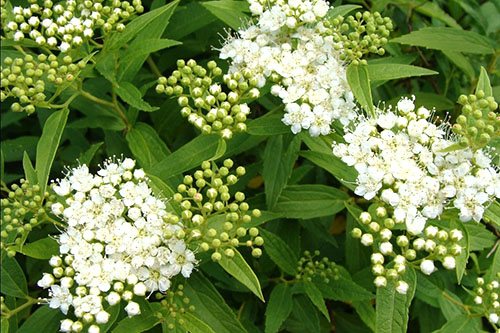

But even with annual spring pruning and care, spirea shrubs, of all types and varieties in the photo below, require replacement after 16 or 20 years.
Among the varieties of Japanese spirea, the most in demand are:
- Little Princess with a rounded crown about 50–65 cm in height, dark green foliage and pink inflorescences that appear in June and remain attractive until August;
- Goldflame with a meter-high crown and decorative yellow foliage and medium-sized pink or red flowers;
- Golden Princess are one meter tall plants with yellow, like Goldflame, foliage and thyroid pink inflorescences;
- Macrophylla is a variety of Japanese spirea, characterized by large wrinkled leaves that turn bright yellow by autumn, among which pink flowers collected in small inflorescences are not too noticeable;
- Candlelight is a compact dwarf plant with pale yellow foliage that brightens towards mid-summer when the pink buds are in full bloom.
Pest control and disease treatment
When growing on a personal plot of such shrubs, you may encounter various pests. Problems are caused by spider mites, aphids, and common garden snails. The gardener will need to regularly examine the spirea and, when the first signs of pests appear, carry out appropriate treatments.
As a preventive measure, it is recommended to carry out sprays with Fitoverm in early spring, which allows you to destroy snails and prevents the appearance of various diseases. Quite often, aphid colonies appear on young leaves, which can feed on the sap of leaves and young shoots. When the first insects are found, the plants should be sprayed with an infusion of hot pepper, celandine or wormwood. Also, the following remedies show excellent results against aphids:
- Etafoson.
- Pyrimor.
- Aktellikom.
Certain problems in the cultivation of sulfur spirea are spider mites, which damage the leaves and significantly weaken the shrubs. The appearance of such spider mites can be determined by small whitish specks on the leaves, as well as their yellowing and drying.As a prophylaxis and fight against this pest, we can recommend that you use the products Karbofos and Fozalonon.
In rare cases, with improper planting care, various fungal diseases may appear, which manifest themselves in the form of numerous gray spots on the foliage. It should be said that the fight against such fungal diseases will be successful if treatment is started quickly. That is why, as soon as you notice the first dark spots and general wilting of the shrub, it is necessary to carry out treatments with colloidal sulfur, Fundazol or Bordeaux liquid.
Spirea Vangutta (Spiraea x vanhouttei)
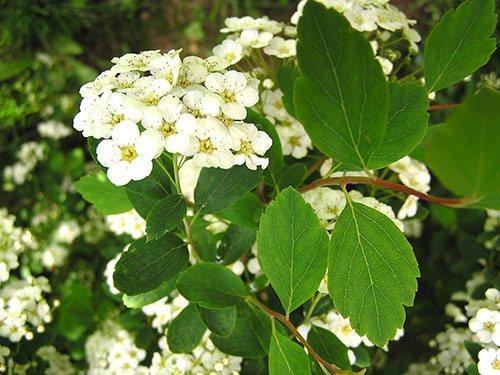

This species is obtained as a result of crossing the Cantonese and three-lobed spirea plants. The Vangutta spirea bushes, growing up to two meters in height and attracting attention thanks to their beautiful spreading crown, are considered the largest in the family.
The leaves of this type of spirea are dark green, with jagged edges of the leaves. In autumn, the foliage changes color to red or bright orange.
The massive appearance of snow-white flowers, collected in thyroid semicircular inflorescences, occurs in the second decade of June. And already in August, under favorable conditions, the plant is ready to bloom again. The shade-tolerant and fast-growing spirea Wangutta in the photo begins to bloom actively at the age of three. The plant is perfect for both group and single plantings.
Spirea gray in landscape design
In landscape design, gray Grefsheim is used in different ways, it all depends on the imagination of the site owner or designer. A hedge can be planted along the paths or used as a fence, then it will simultaneously function as a fence and decor. It easily disguises garden supplies, be it irrigation barrels or storage equipment.
The Grefsheim hybrid is also used for single plantings. For example, in the center of a meadow with a lawn, near the porch, creating a bright accent for an alpine slide. The classic style involves planting gray Grefsheim spirea near water bodies.
It is difficult to find plants with which gray Grefsheim spiraea would be poorly combined. It looks great with undersized ornamental shrubs: euonymus, broom, viburnum. You can plant the Grefsheim hybrid variety next to tulips, daffodils, primrose, crocuses.
Spirea Bumalda (Spiraea x bumalda)
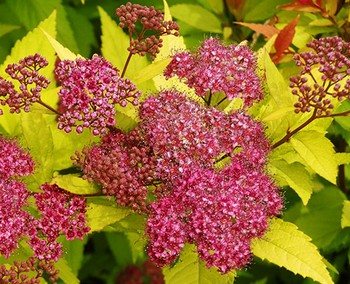

A hybrid, artificially bred species obtained from crossing a white-flowered and Japanese spirea, which is similar in appearance, but does not exceed 80 cm in height. The Boomald spirea bush has erect branching shoots with brightly colored foliage, especially in autumn. Already in mid-August, the leaves become yellow, crimson and scarlet. The brightest autumn foliage is in the bushes that are in a sunny area. In summer, from the end of June and for a month and a half, the shrub is decorated with dense pink inflorescences.
Read also: Currant anthracnose: treatment of the disease with drugs and folk remedies
Among the popular varieties of Bumald's spirea:
- Anthony Waterer, adorned with bright red flowers throughout the summer and looks good in single plantings, as well as when organizing large flower beds;
- Dart's Red is a shrub of half a meter in height with erect shoots, on which leaves with a pink tint bloom in spring, turning green in summer and acquiring a deep red color in autumn.
Spirea cuttings
Several cuttings can be obtained from one plant at once. It is convenient and cheap if you need, for example, to prepare material for planting hedges. Branches are cut specifically for reproduction, or specimens obtained as a result of formative or sanitary pruning are used.
The deciduous spirea shrub tolerates pruning well, resulting in a more attractive appearance.
Advice! We carry out pruning work in cloudy weather or after rain.We also choose the sharpest pruner to cut the branch in one step.
You can harvest twigs for breeding in spring, summer and autumn. The process of cutting, planting and caring for cuttings at any time of the year is almost identical. In each case, the transplantation of the rooted shoot to a permanent place is carried out only the next year.
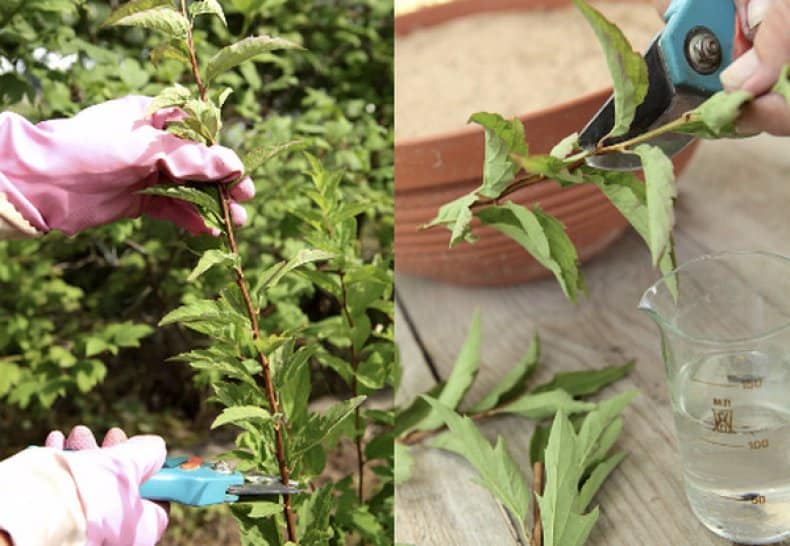

Getting spirea cuttings in spring
In May, take annual shoots of brown color, they are semi-lignified. The length of the handle is chosen 12-15 centimeters, the number of internodes on it should be 4-5 pieces.
Advice! Cut the upper part of the shoot straight (just above the bud), and the opposite part at an oblique angle (we retreat a little from the extreme lower bud).
We always use twigs that grow vertically, it is good if they are straight. Taking into account the season, we help the cuttings with special stimulants so that they take root faster and more painlessly.
You can use epin, zircon (liquid preparations), then granular or powdery heteroauxin, root.
We plant the prepared cuttings in wet sand or peat, cover with polyethylene (a cut plastic bottle). Pots, containers, mini greenhouses, greenhouses or special cuttings - there are many options for planting.
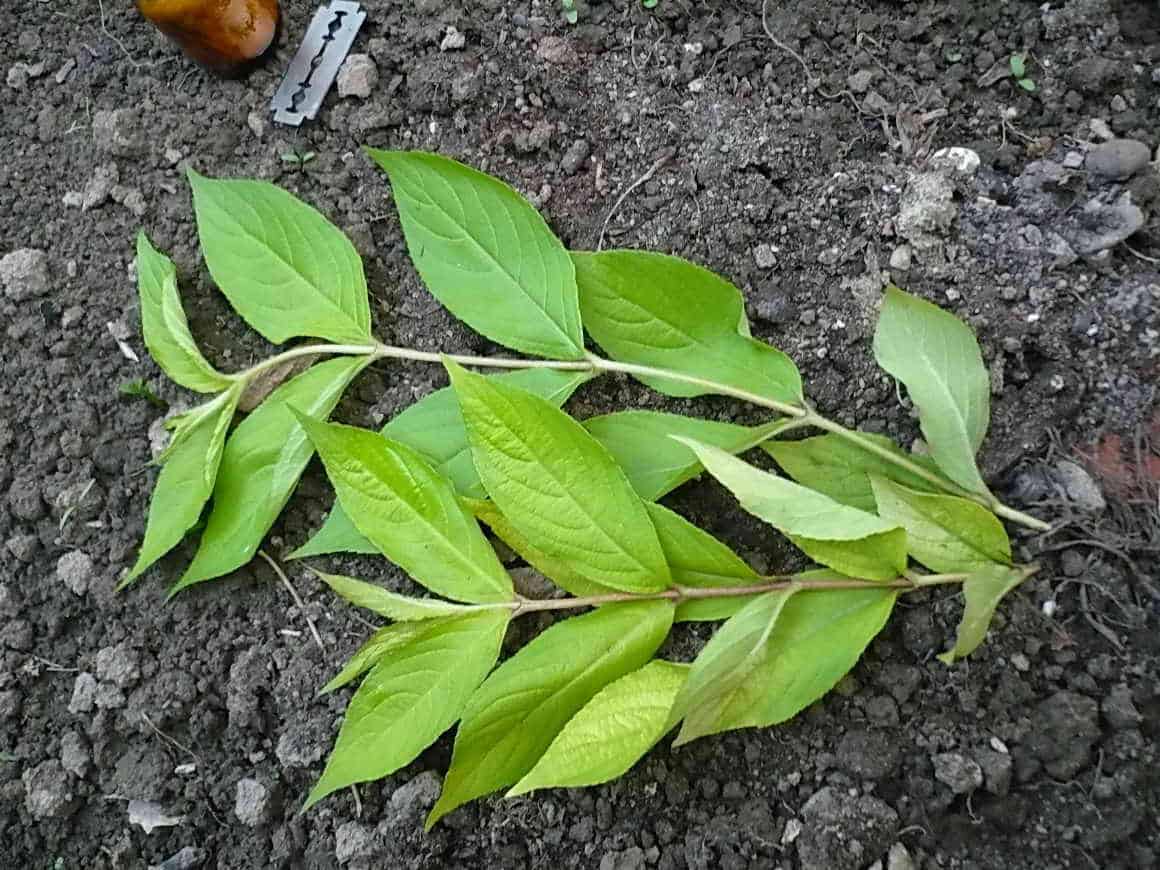

Spirea cuttings in summer
In June (Japanese spirea) or July (most other species), we take shoots that have just faded, and leaves on them grow from each internode. Gardeners successfully use both green young twigs and semi-lignified annual stems.
- The length of the handle is 10-15 centimeters, the buds on it are at least 4;
- Remove the lower leaves, and cut the upper ones in half;
- Put the branches in a solution of a root formation stimulator (epin) for 4-6 hours;
- Before planting, dip the lower cut into a dry root or heteroauxin (do not shake off);
- You need to plant in a mixture of wet sand with peat, or just in wet sand or vermiculite, in any case, the soil should be light and loose;
- We put the branches in the ground at an angle, deepening, no more than 3 centimeters.
Sprinkle some water over the shoots and cover them with plastic wrap or a plastic bottle (remove after a couple of weeks). A warm, humid environment is created for the seedlings. From time to time we water and spray the shoots, avoiding drying out and waterlogging.
Sprinkle seedlings overwintering on the street with peat or spruce branches. For the winter season, containers or boxes are also brought into the basement, the pots are left in cool rooms or on a dark windowsill.
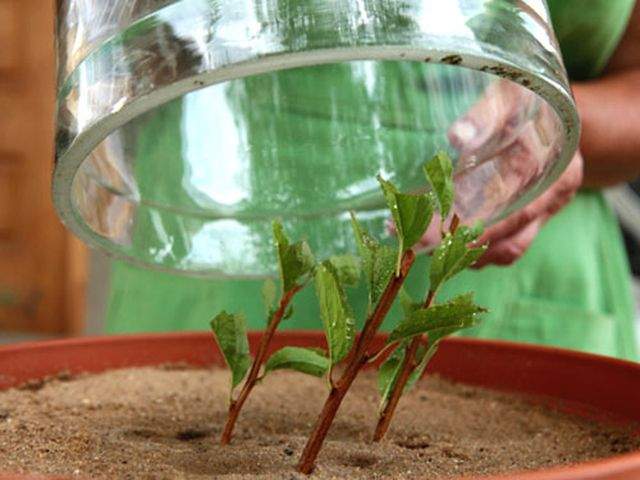

It is convenient to root spirea shoots both in a pot and in a greenhouse. I am building a kind of greenhouse for cuttings of any garden crops. I do this:
- I am digging a small bed in a sunny area;
- I bring in humus, peat and sand, water;
- I level and plant shoots at a distance of at least 10 centimeters;
- I stick in the arcs directed from east to west and cover them with polyethylene;
- I sprinkle the edges of the film with earth (you can strengthen it with bricks or boards), and shade from above with tree branches (I have bird cherry or willow);
- From the ends I do not cover with branches, there is only a film.
Sometimes we ventilate the cuttings, water them, and for the winter we remove the film cover and sprinkle the rooted seedlings with peat or humus.
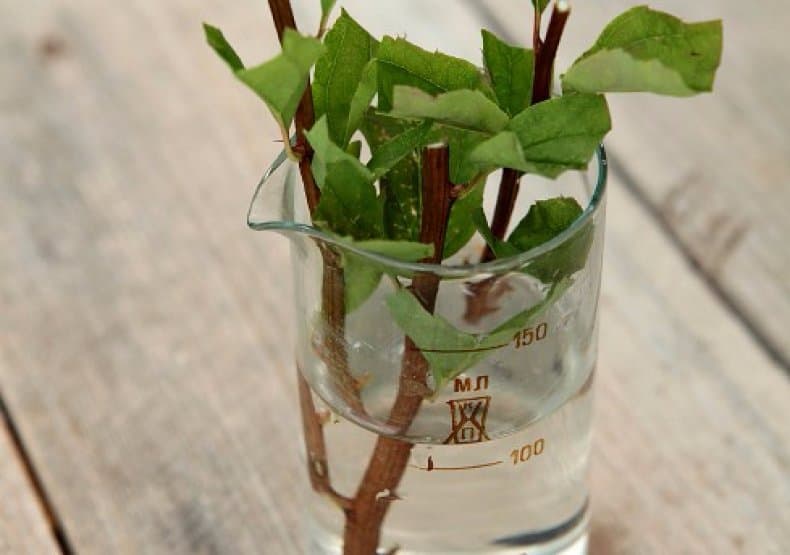

Spirea gray (Spiraea x cinerea)
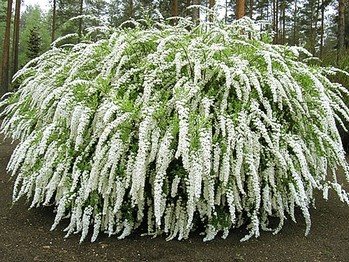

Spectacular gray spirea is a hybrid plant not found in the wild. The shrub has graceful drooping shoots from one and a half to two meters high. During the flowering period, they are strewn with white flowers on corymbose inflorescences. The plant got its name thanks to the lanceolate leaves, which have an unusual silvery-green color. Flowering begins in mid-May and lasts up to one and a half months.
Fruits appear on the branches in July, but they cannot be used in plant propagation. The hybrid species reproduces only by cuttings. And already in the third or fourth year after planting, young bushes of gray spirea begin to bloom.
Recommendations for the care of sulfur spirea
The popularity of this ornamental shrub is largely due to the ease of caring for it. We offer you fairly simple recommendations for caring for a shrub.
- The gardener should ensure that the spirea sulfur is properly watered, especially in hot and dry weather. In the height of summer, the bushes should be watered twice a week. Moreover, watering is carried out with settled warm water.
- It is recommended to loosen the soil to a depth of 5-8 centimeters. At the same time, weeds should be removed, which can significantly slow down the growth of this ornamental shrub. Remember that it is not recommended to loosen the earth to a depth of more than 10 centimeters, since the Grefsheim spirea has roots located at the very surface that can be damaged by careless handling.
- Shrub pruning is not difficult. It is recommended to carry out this procedure in the spring before bud break. Also in the fall, the shoots should be slightly trimmed, giving the shrub the desired crown shape. In the spring, before the flowering of the shrub, it should be examined to identify damaged and frostbitten shoots. They must be shortened to avoid drying out and damage to the ornamental shrub.
- 10 years after planting, a rejuvenation procedure should be performed. For this, the bush is cut under the stump. All shoots are removed, and several dormant buds are left above the root collar. Within a few years, a new lush bush will be formed, which will be distinguished by fast growth and excellent flowering.
- Correct feeding of spirea will guarantee excellent flowering and rapid growth. This top dressing is recommended to be performed in early spring, even before the buds begin to spill out. Spirea can be fed with diluted slurry, for which chicken manure or mullein is used. You can also irrigate with warm, settled water with a small addition of superphosphate. In this case, you need to add 8 grams of superphosphate to a bucket of water. The resulting nutrient solution will be enough to water one bush.
Excellent results are shown by the use of mineral fertilizer Kemira universal, which improves growth and guarantees lush flowering of the shrub. About 90 grams of such a mineral fertilizer will be required per square meter of near-trunk soil.
Spirea Grefsheim is distinguished by excellent indicators of frost resistance. The only thing that this shrub does not like is the frequent and sharp changes in temperature. It is recommended in regions with cold and snowy winters to mulch the soil, for which you can use dry foliage or peat.
With proper care and appropriate anti-aging pruning, the shrub will fully develop and bloom for 30 years.
Spirea nippon (Spiraea nipponica)


This type of spirea comes from plants from the Japanese islands. The nippon spirea has a spherical crown shape, reaching two meters in diameter. The bush is dense with horizontally directed branches and small oval green leaves. Flowering begins at the end of May or June and lasts about a month. The inflorescences, scabiform, densely covering the shoots, are composed of white or yellowish flowers. In this case, unopened buds can be painted pink or purple.
Spirea nippon is ideal for single plantings. The plant is not demanding on the soil, but loves well-lit areas.
Russian gardeners have a popular variety Halward's Silver about a meter high and large white inflorescences. Summer residents like the tall, up to two meters in height Snowmound with elongated leaves and snow-white flowers.
Diseases and pests of spiraea gray Grefsheim
Although spiraea is considered a sturdy shrub, it also has pests, albeit a few. To avoid trouble, it is advisable to carry out preventive work.
- The spider mite affects not only this type of shrub.The main signs of sabotage are the appearance of cobwebs on the shoots, yellowed out of time and fallen leaves, holes in the leaves and inflorescences and an unhealthy look of a shrub. It is easy to get rid of it by spraying with 0.3% karbofos.
- Aphids primarily harm inflorescences and young foliage, as they bite off and suck out the juice. To destroy aphids, spraying with a 0.1% solution of pyrimor is suitable, which is also harmful to other types of pests.
- Rose leafworm is able to destroy from 20% to 60% of shrub leaves. The caterpillar twists and gnaws them.
If spiraea is sprayed with chemicals before the vegetative period, then it is not in any danger, since this plant is extremely rare.
Spirea Douglas (Spiraea douglasii)
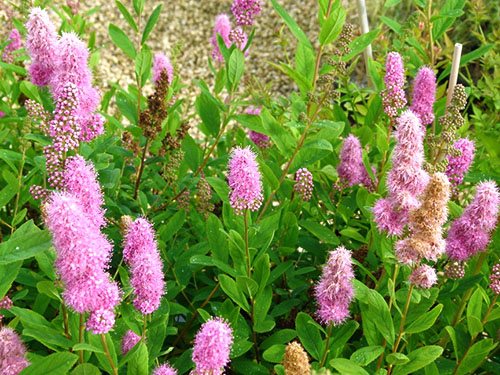

The unpretentious North American species of spirea forms a one and a half meter bush with pubescent, straight shoots with a red-brown bark. Flowering begins at the age of three, falls in July and lasts until autumn.
The leaves of the Douglas spirea are oblong, lanceolate, evenly cover the erect shoots, on the tops of which there are fluffy pink inflorescences of a narrow pyramidal shape.
More about grafting
To propagate spirea in a vegetative way, you need to take cuttings, the size of which is about 10 cm and plant in fertile soil. The planting material takes root within 2 months.
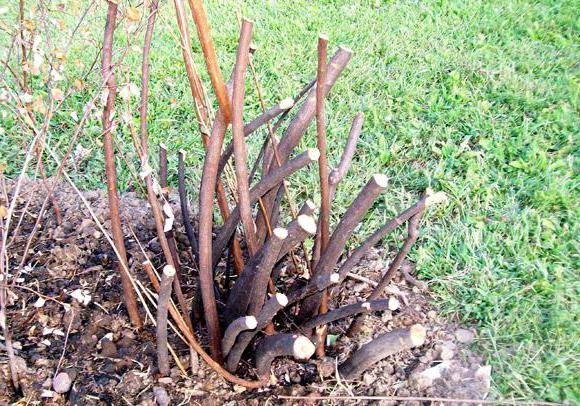

Then he is transplanted to a permanent place. Young, almost green cuttings are not used for propagation of this culture. I placed the planting material at a distance of 30 cm. Spirea Grafsheim makes a magnificent hedge!
Spirea willow (Spiraea salicifolia l.)
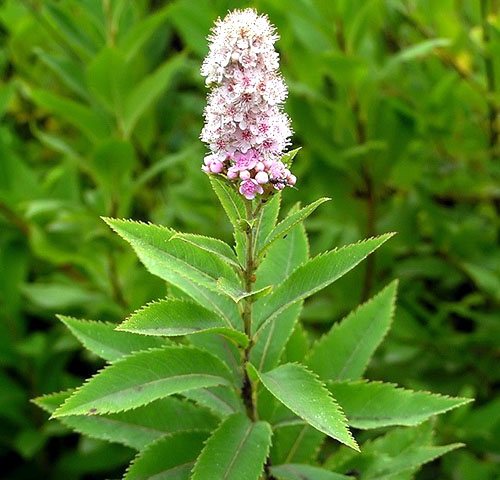

The two-meter willow spirea lives in a number of regions of Siberia, in the European territory of Russia and in the countries of the Far East. In the wild, shrubs with straight shoots covered with red-brown bark are found in swampy areas of river floodplains, near the shores of lakes and forest channels.
The plant has sharp-pointed leaves, excised at the edges, reaching 10 centimeters in length, and flowers collected in paniculate or pyramidal inflorescences are pink or white. The bushes of willow spirea tolerate winters well, they love moist, loose soils and sufficient lighting. You can propagate a plant by cuttings or using seeds. And the mass flowering occurs in the fourth year of the life of the decorative culture.
Planting and caring for Sriraya sulfur
- Bloom: in May.
- Landing: from mid-September to mid-October.
- Lighting: bright sunlight.
- The soil: fertile, moist, breathable.
- Watering: once a week, in drought - twice a week. In the season with normal rainfall, you do not need to water.
- Top dressing: before flowering, add Kemira-universal solution to the trunk circle, and after pruning - mullein solution with superphosphate.
- Cropping: annually after the end of flowering.
- Reproduction: only vegetative - by layering and cuttings.
- Pests: snails, rosacea, aphids and spider mites.
- Diseases: ascochitis, septoria or ramulariasis.
Read more about the cultivation of Sriraya sulfur below.
Spirea Billard (Spiraea x billardii)
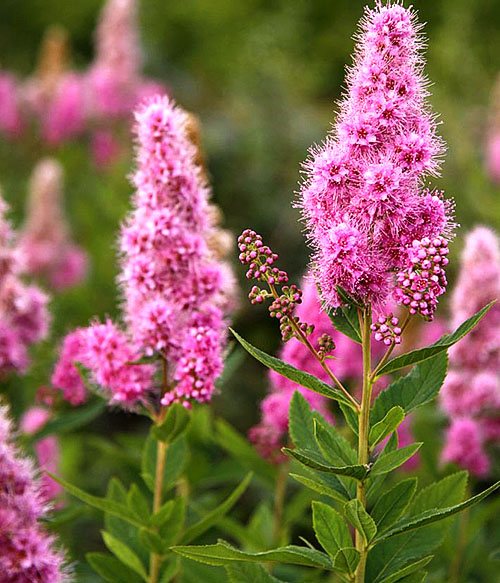

Billard's vigorous spreading spirea is a hybrid form, the result of artificial crossing of willow spirea and Douglas spirea. The crown, up to 2 meters in diameter, is covered with jagged oblong ten-centimeter leaves, covered with silvery hairs on the back.
The flowers of this spectacular species are bright pink and open in the second half of July. They form panicle inflorescences that adorn the bush before the cold weather, which the spirea can easily tolerate. It is easy to propagate the spirea of this species, which does not produce fruit, with the help of cuttings. At the same time, sunny areas with moderately nutritious soil are suitable for planting.
For Billard's spirea, spring pruning is desirable, stimulating the emergence of young shoots and the development of new flower buds.
Landing
The most favorable time for planting gray spirea is autumn, until the end of leaf fall, but you can plant it in spring, before the buds appear. The best weather is a cloudy day ideal if it rains.
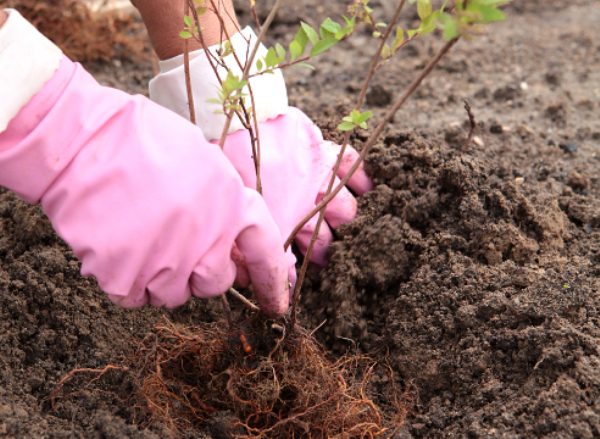

Planting gray spirea in the ground
For landing, you need to choose sunny place. Planting in the shade is possible, however, in this case, the gray spirea will develop more slowly and the flowering will not be plentiful. The soil should be nutritious and loose.
Heavy soil should be diluted with leafy or soddy soil, and clay soil with peat or sand.
To plant a seedling, you need to dig a hole that will be much larger than its root system. Since gray spirea prefers moderate humidity, drainage must be placed on the bottom of the pit. The drained bottom should be sprinkled with soil mixed with fertilizer, the seedling should be laid on top, spreading its roots and sprinkling them halfway.
Before planting, the roots should be inspected and cut dry and too long.
Next, you need to fill the hole to the end and water the seedling with about a bucket of water. After the moisture has been absorbed, the seedling needs to be pulled up to allow the roots to take a comfortable position. After that, you need to compact the soil, water and sprinkle with mulch in order to retain moisture.
Sulfur spirea needs a large area, since its root system grows strongly.
Spirea Arguta (Spiraea x. Arguta)
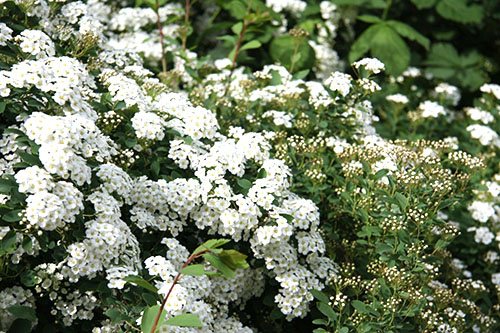

A tall, spreading bush of 2 meters in height with drooping branches, from May covered with white inflorescences in the form of semicircular caps, is one of the early flowering hybrid species of spirea. The buds bloom at the end of May, and until mid-June, the Argut spirea is a spectacular sight. From under the mass of flowers, dark green lanceolate leaves with jagged edges are practically invisible.
Flowering takes place on the branches of the previous year, which are pruned after the inflorescence wilting. The best place for the Argutta spirea is in the center of a flower garden or hedge. It is important to take into account the low growth rate of these plants.
Ornamental shrub spirea - video
Shrub propagation
Due to its hybrid origin, gray spirea cannot be propagated by seeds. Most gardeners practice vegetative propagation in two ways:
- Layers.
- Cuttings.
Cuttings should be harvested immediately after flowering, after which they are deepened into a substrate of coarse river sand and peat. With this reproduction of sulfur spirea with the help of cuttings, it is necessary to monitor the soil moisture, regularly watering it, which will ensure fast and high-quality rooting. Treatment of cuttings after harvesting in a solution of indolylbutyric acid also improves rooting rates. This processing is carried out within 16 hours. We can recommend that you additionally carry out the treatment with Epin's solution.
The reproduction of sulfur spirea with the help of layering is also very popular. It is necessary in early spring, before the foliage appears on the bush, to bend several branches, some of which are slightly buried in the soil. Usually, by autumn, such shoots have a full-fledged root system in the ground, after which such a rooted shoot can be separated from the mother plant and transplanted.
Ash spirea and varieties of this plant are an ornamental shrub that is easy to grow and has an attractive appearance. Spiraea gray grefshame, a description of which you will find in this article, is a fast-growing shrub that can grow up to a height of two meters. You can use a spirea for a hedge or plant such a shrub to decorate your backyard. Caring for spirea is not difficult, so every gardener and ordinary homeowner can cope with its cultivation.
Popular types and varieties of spirea for your garden - photos, names, descriptions
Adding an article to a new collection
Spirea is prominent among the ornamental shrubs. For lush flowering, unpretentiousness and frost resistance, she won the love of summer residents, landscape designers and breeders. But some types and varieties of spirea are held in high esteem.
The name of this shrub, translated from Latin, means "bend": the branches of the plant form a graceful arc. People sometimes call spirea a meadowsweet, but this is not true. Meadowsweet and spirea have similar inflorescences, but they are different plants.
Spirea is a shrub of the Rosaceae family, which has almost a hundred species. All of them are undemanding to growing conditions, multiply easily, grow quickly, bloom for a long time, tolerate a haircut well and have many other advantages. Today, spirea is widely used to decorate summer cottages and city parks.
Spirea can live on the site for tens of years
The height of the spirea can vary from 50 cm to 2.5 m. The flowering time - depending on the species - occurs in spring, summer or autumn. The shape of the crown is spherical, weeping, pyramidal, cascading or erect. In addition to flowers, spireas also decorate the site with decorative foliage. Many varieties have been bred with an openwork leaf shape. In autumn, they change color to bright red, yellow, orange.
All types of spirea are divided into two large groups: spring-flowering and summer-flowering.
IV. Pests and diseases
Spirea Grefsheim is classified as a plant that is resistant to diseases and pests. But sometimes she is struck by these misfortunes. Among the pests of gray spirea are seen:
- spider mite;
- aphid;
- blue meadow sawfly;
- whitefly.
The activity of spider mites causes yellowing and shedding of foliage and slows down the growth of the plant. After detecting warning signs, spirea is sprayed with Phosphamide or Karbofos. Aphids bite off the inflorescences and suck the juice out of them. Perimor is used against her. The preparations Inta-vir and Fitoverm will help to cope with the whitefly and the sawfly. The correct agrotechnics of meadowsweet can prevent the appearance of pests - timely watering, top dressing and spraying.
The shrub can be affected by spotting and gray mold. When signs of disease appear, the plant is treated with Fundazol or colloidal sulfur. It is better to do the treatment before or after flowering.
Spring flowering spireas and their varieties
Spring species of spirea form inflorescences of predominantly white and cream shades. Flowering is usually very lush, at this time the bush becomes like a white cloud. Due to this, spring spireas are sometimes called May snow. We list some of the most common types of this type.
Read also: Cherry tomatoes for the greenhouse - tomato varieties similar to cherries: how to grow the best varieties and care for the bush when growing?
Spirea Wangutta (Spiraea x vanhouttei)
This hybrid spirea is a medium to tall shrub, which at the end of May is covered with a dense cascade of white flowers. Tall varieties look great singly, while lower varieties look great in mixed plantings. Spirea Wangutta is also suitable for hedges.
The most popular variety is Pink Ice, with variegated leaves and creamy buds.
Spiraea Wangutta Pink Ice is an ideal plant for specimen planting
Spiraea oak-leaved (Spiraea chamaedryfolia)
One of the first to bloom - in early or mid-May. The shrub grows up to 1.5 m, sometimes slightly taller. This species reproduces well by root shoots, so it is often planted in city parks. Also, the oak-leaved spiraea easily tolerates a haircut, therefore it is excellent for hedges.
Spiraea oak-leaved - not only an ornamental plant, but also a good honey plant
Spirea nippon (Spiraea nipponica)
It is a lower ball-shaped shrub. Its height usually does not exceed 1 m. It blooms very profusely in late May and June. The varieties Snowmound and Halvard Silver are especially effective.
Spirea Nipponskaya varieties Snowmound (left) and Halvard Silver (right)
Spirea Thunberg (Spiraea thunbergii)
In the wild, Thunberg spirea is found on mountain slopes and in valleys. The bush reaches a height of no more than 1.5 m. Its dense branches are covered with graceful leaves, which change their color from green to orange in autumn. Lush white inflorescences adorn the spirea from May to June. The plant prefers sunny places and in the middle lane it can freeze slightly in severe winters.
The most popular varieties are Fujino Pink (with pale pink inflorescences on drooping branches) and Ogon (with golden-green willow-like leaves and white inflorescences).
Spirea Thunberg Fujino Pink (left) and Fire (right)
Spirea crenate (Spiraea crenata)
Spectacular shrub up to 1 m in height with a loose crown and obovate leaves of a grayish-green color with a characteristic crenate edge and protruding veins. Yellowish-white flowers are collected in corymbose inflorescences.
Thanks to the well-developed root system of the spirea, the crenate is not afraid of frost or drought.
Spirea gray (Spiraea x cinerea)
It is a hybrid of Spiraea hypericifolia and whitish-gray spirea (Spiraea cana). The plant is a shrub up to 2 m high with branched shoots, gray-green pointed leaves and white flowers, collected in loose inflorescences-shields. This spirea blooms in May - early June.
The Grafsheim variety is especially interesting. It is a small densely branched shrub with arched drooping branches, narrow leaves and large white double flowers.
Grafsheim is not only a very beautiful, but also a perfect unpretentious variety. The bush grows very quickly, tolerates a haircut well, is not afraid of the cold and does not need good lighting
II. Growing conditions
The shrub is unpretentious:
- growing rapidly;
- tolerates pruning well;
- unpretentious to the characteristics of illumination;
- resistant to moderately low and high temperatures.
For the full disclosure of the properties of gray spirea, the minimum conditions for planting and care should be observed. The bush does well in shaded conditions, but in this case, its growth may slow down. For its intensive development, you need to choose a well-lit place. Meadowsweet takes root in any soil. The main thing is that it is not overdried.
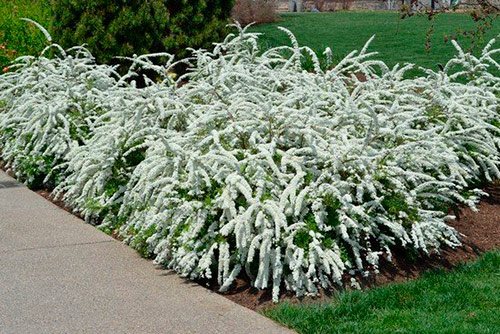

Terry flowers on falling branches are a wonderful honey plant. Gardeners plant shrubs to attract insects to the garden. This technique increases the yield of fruit and berry crops.
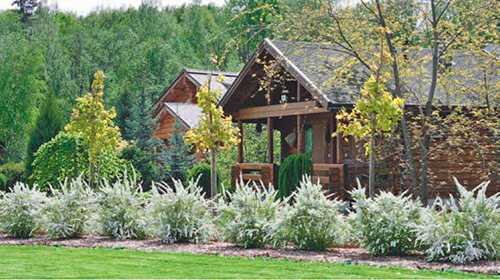

The spirea hedge is not only beautiful, but also practical. Bushes grow up to 1.5 - 2 meters. The plant grows rapidly and fills the space. Planting plants is recommended at a distance of half a meter from each other.
Adult representatives of the Grafsheim variety are unpretentious to air humidity. High humidity is needed during reproduction - to activate the growth of cuttings. During this period, the cuttings are often recommended to be sprayed or watered.
Summer flowering spireas and their varieties
In spring spirits, flower buds are formed on two-year-old shoots, and in summer spirits, on the shoots of the current season. Therefore, they are often cut off. Summer-flowering spireas are distinguished by inflorescences, as a rule, of different shades of red and pink. Here are the most famous species.
Spirea willow (Spiraea salicifolia)
It usually grows from 1 to 2.5 m. From the end of June, the upright shrub is covered with light pink inflorescences. Light foliage, similar in shape to willow, takes on a red tint in the fall.
Willow spirea is most often grown in hedges.
The most popular in gardens is the large-flowered form of willow spirea (f. Grandiflora) - with more lush light pink flowers.
White-flowered spirea (Spiraea albiflora)
It is named so because it is one of the few summer species with white flowers. It blooms for a long time from the second half of summer, exudes a pleasant aroma. The bush is usually low - 1-1.5 m.
Of the bred varieties, it is worth noting Macrophila.Its foliage changes color twice: young leaves are red, gradually they turn green, and in autumn they turn yellow.
Spirea white-flowered variety Macrofila is famous for its large leaves
Japanese spirea (Spiraea japonica)
This is the most common spirea. It has a small height (usually about 50 cm), blooms for one and a half to two months, starting in mid-summer. Looks good in curbs and group plantings.
Among the many varieties, one of the most spectacular is Shirobana. On one bush, flowers of white, pink and red shades are found at the same time. Also good varieties are Golden Princesses (distinguished by golden foliage), Gold Mound (leaves are also golden, but darker and with a pink tip).
Spirea Japanese varieties Shirobana, Golden Princesses and Gold Mound (from left to right)
Spirea Douglas (Spiraea douglasii)
Shrub up to 1.5 m high with straight, reddish-brown, pubescent shoots, oblong-lanceolate silvery-green leaves and dark pink flowers, collected in narrow pyramidal or paniculate inflorescences. The plant blooms from July to August for approximately 45 days.
Spirea Douglas is often used to strengthen slopes and slopes
V. Decorative shrub
Spirea Grafsheim is very popular in landscape design. A hedge from it is planted around the house or along the paths. She will successfully disguise garden plantings and household "little things" (barrels of water for irrigation). Spirea Grefsheim is also used in single plantings: in the center of the lawn, near the porch, at the bend of the path. The bush branches will decorate the stone garden, highlighting their primitiveness with whiteness. And cut shoots are good in bouquets of roses.
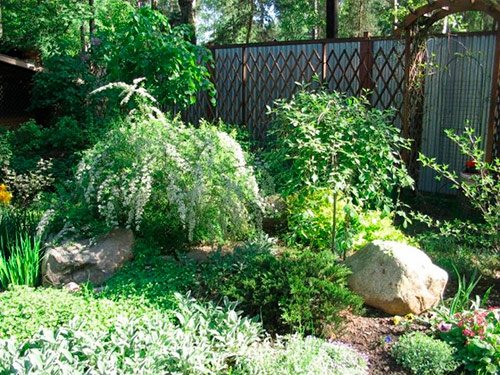

Spiraea of the Grafsheim variety will become the most beautiful plant on the alpine slide. You can pick up ground cover plants with white flowers or shade the spirea with brighter plants.
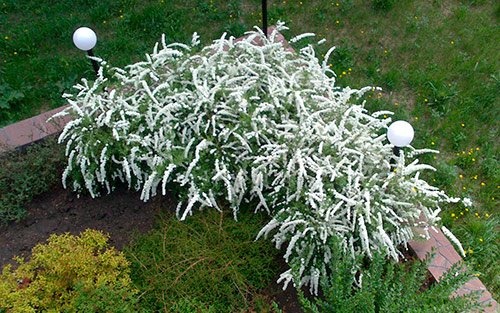

Spirea Grefsheim perfectly coexists with other shrubs. In autumn, the green leaves of the plant acquire a golden color, they illuminate the bush with hundreds of small suns
For the neighborhood with the Grafsheim variety in the landscape, other types of spirea (nippon, arguta, medium) and undersized shrubs are suitable:
- gumi;
- the colquity is lovely;
- viburnum;
- broom;
- euonymus.
Gray spirea looks great in combination with conifers.
Spirea Grefsheim is quite easy to care for. It reproduces well and gets along well with other shrubs, making it possible to create spectacular "live" ensembles. The decorativeness of the shrub is rightfully in demand by gardeners and landscape designers.
Spirea Bumalda (Spiraea x bumalda)
This hybrid of Japanese and white-flowered spirits is found in gardens even more often than its "parents". Spirea Bumalda is a short shrub (up to 75 cm) with a spherical crown, erect branches, ovate-lanceolate leaves and pink or crimson flowers.
The most popular varieties:
- Gold Flame (pink flowers, leaves when blooming are bronze-orange, later - golden-yellow, in summer - greenish-yellow, and in autumn - copper-orange);
- Darts Red (inflorescences of a rich crimson color, leaves are pinkish when blooming, in summer they are dark green, and in autumn they are red).
Spirei Gold Flame (left) and Darts Red (right)
Plant pests
Spiraea can be attacked by spiders. Insects stain leaf blades and have a detrimental effect on photosynthesis. Spiders feed on cell sap. They eat the leaves, making holes in them, and also infect the inflorescences of the spirea. To expel spiders, you must use a very weak solution of karbofos. The product is applied from a spray bottle.
Aphids are no less dangerous pests. She also feeds on cell sap, damages inflorescences and leaf plates. To remove aphids, you need to use insecticide preparations.
Caterpillars are also harmful. They mainly attack the leaves. In the fight against such pests, insecticides are used.Preventive treatment can be carried out before the beginning of the growing season.
Reproduction of spirea in Siberia
This culture reproduces in several ways. Each of them has its pros and cons, with some varieties only one way is suitable. For example, Billard is only bred by cuttings.
- Seminal. Only species-specific shrubs reproduce, hybrid varieties do not produce fruit. The seeds are collected from ripe bolls. The germination rate is high. Seeds are sown in a prepared container, water, cover with foil. Remove the film after emergence. When 2-3 leaves appear, dive.
- Layers. A simple and effective way. Bend the lower branches of the bush to the ground in spring, fix, sprinkle, leaving the top. In the autumn, plant the cuttings on a permanent site.
- Cuttings. The rooting coefficient is 70. Depends on the flowering period: the early shrubs are cut in the first days of June, the late ones - in July. If the cuttings are lignified - carried out in the fall. Prepare cuttings with 5-6 leaves, the recommended length is 0.1 m. Remove the lower foliage. Soak in a growth stimulator for half a day. Plant in prepared containers with soil mixture at an angle. Cover with jars or plastic wrap. Irrigate periodically and water regularly. For the winter period, dig in the cuttings and cover them, and in the spring, plant them on an area of constant growth.
Compliance with simple planting and care requirements contributes to the active development and abundant flowering of the shrub, timely preventive treatment will save the flower from pests.
Planting basics
When purchasing planting material, it is better to give preference to young compact plants without leaves with flexible branches and healthy buds. Spirea is not very demanding on growing conditions in the open field. And if there are no factors that strongly inhibit its development, then in one place it grows beautifully for a long time. You can not transplant for 10-15 years.
Best drop off time
Late-flowering spireas are best planted in spring, when the ground thaws and positive air temperatures are established. Autumn planting (in Siberia - September) is preferable for species that bloom in spring.
The people use this guideline: you can plant until all the leaves from the trees fall.
Seat selection
In sunny, not flooded areas, the flowering of the spirea will be long, and the inflorescences will be bright. Penumbra is acceptable for her, and landing on an area with a close occurrence of groundwater can be disastrous.
Soil and pit preparation
Low soil fertility will not significantly inhibit growth. Loose, breathable fertile soil is optimal. Before boarding:
- A pit is prepared, 1/3 larger in size than an earthen lump, covering the roots.
- Withstand several weeks for the earth to settle.
- A drainage layer (15–20 cm) is placed on the bottom.
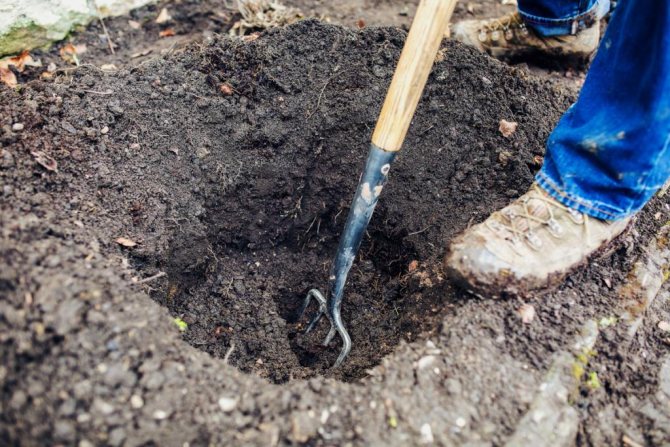

Preparing a pit for planting spirea
Process technology
Further actions will be as follows:
- the soil from the pit is mixed with fertilizers;
- if the seedling is not in a container, a small mound of soil is formed at the bottom, around which the roots are evenly spread, the dried ones are pre-moistened, damaged and rotten ones are removed (if any);
- the hole is half covered with earth;
- pour out a bucket of water;
- fill up the rest of the soil;
- water again;
- form an earthen wall around the planted plant;
- the root zone is mulched.
The root collar must remain at ground level.
Growing tips, nuances
Keep in mind that for the first time spirea blooms only in the third year after planting. You should be patient - the decorative spectacle of the flowering shrub is worth it.
It is also important to know that the root system of the plant is superficial, therefore, it cannot take moisture from deep layers of soil. Therefore, do not allow the roots to dry out, and be sure to water regularly with spirea, in the heat - twice as abundantly.
The spirea bush lives for about 17 years, but if, upon reaching the age of four, it did not please with abundant flowering, it is better to replace it with a higher quality specimen.
Japanese spirea is a real decoration of the garden, striking with a unique combination of delicate flowers and bright color of leaves. In addition, the shrub is unpretentious, so novice gardeners can also grow it. And our advice will definitely help you with this.
Flowering groups
All spirea shrubs are conventionally divided into spring flowering and late flowering. Spring-flowering - bloom profusely, covering the bushes with lush light inflorescences for a month.
This group is not subject to spring pruning, because they have autumn budding.
The second group - late flowering, begin flowering from mid-June and bloom almost until the end of autumn. At the same time, new buds are tied to replace the fading ones. Therefore, you should carefully remove dried inflorescences.
Pruning of this group is carried out at the end of autumn or with the arrival of the first heat.
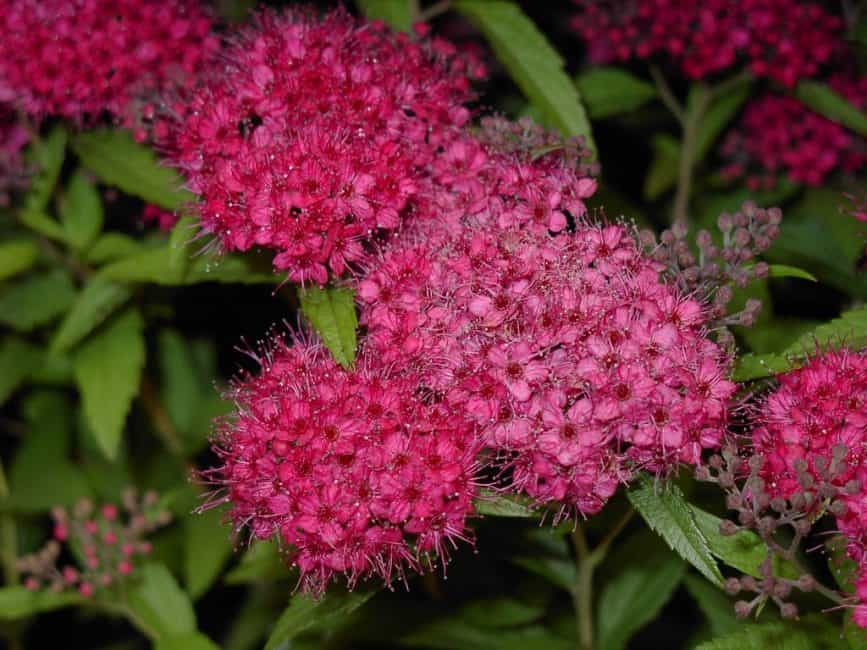

general description
The height of the shrubs varies from dwarf varieties to large-sized ones, reaching 2 meters in height. Spirea grows at the same time quickly, regardless of growth. The natural shape of both the bush itself and all its parts is different. There are weeping, pyramidal, forming cascades and hemispheres, erect and even creeping species. Shades of inflorescences - from pure white (in most varieties) to rich crimson, their shape is paniculate, spike-shaped, spherical, corymbose, there are also varieties with single flowers. The shape and color of foliage can also vary greatly (color differences are especially noticeable in autumn). All varieties are undemanding to the soil, most of them are frost-resistant and tolerate urban conditions well. They begin to bloom at 3-4 years of age, the fruits ripen (not in all varieties) 1.5-2.5 months after the end of budding.
The first flowering may be limited to rare and often unblown buds. This is normal and you shouldn't worry about it.
Among the people, the plant received another name - meadowsweet (in the southern regions with an emphasis on the end of the word, in the north - at the beginning). In popular sources, these two names are considered synonymous, although this is not entirely true. All types of spirea, with all their huge diversity, are shrubs, while the meadowsweet genus, with a striking external similarity, includes exclusively herbaceous crops.
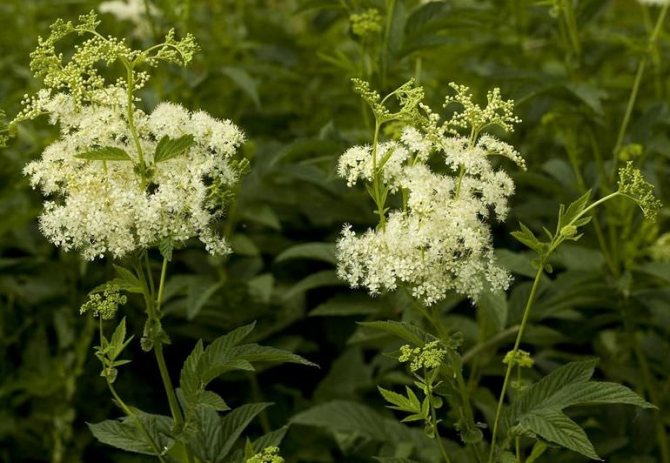

Spiraea
How and when to plant?
The shrub is planted in the spring or autumn, it depends on the selected variety and flowering period. When flowering in spring, it is recommended to plant in autumn. Optimal time: August - early September. Late varieties should be planted in early spring.
- First, a landing pit is being prepared. This is done several days before landing. Depth up to 0.7 m, width depends on the type of shrub and the degree of development of the root system.
- When planting more seedlings, it is recommended to maintain a distance. If the planting is supposed to be used as a hedge, the distance is from 0.3 to 0.5 m. For single seedlings: undersized - 0.8 m, tall - at least a meter.
- Lay a drainage layer at the bottom, it is recommended to use crushed stone, crushed brick, expanded clay.
- If a seedling with open roots, it must be placed in liquid, and the bush in the container must be watered.
- Further, it is recommended to trim the shoots and shorten the roots by 2-3 cm.
- Mix the soil with fertilizers, heat the hill, place the bush on it.
- Sprinkle the shrub with soil, compact thoroughly, water.
- Be sure to mulch, use peat, humus, pine needles.
Proper care is the key to beauty and abundant flowering
Spirea is quite undemanding in leaving. For good lush flowering and normal growth, the shrub needs a lot of sunlight, fertile land and watering.Shelter of the spirea for the winter is not always required, only in the northern regions with a harsh cold climate and young plants planted in autumn.
A spirea planted in spring should be well watered, especially in the southern regions, in the Kuban, where spring and summer can be quite hot. In summer, pay special attention to watering, make sure that the soil in the near-trunk circle does not turn into an earthen crust, it is important for recently planted spirea plants.
The space near the trunk can be covered with peat to create an optimal microclimate and moisture retention. Instead of peat, you can use humus, which will retain moisture and will be a good fertilizer that feeds the spirea.
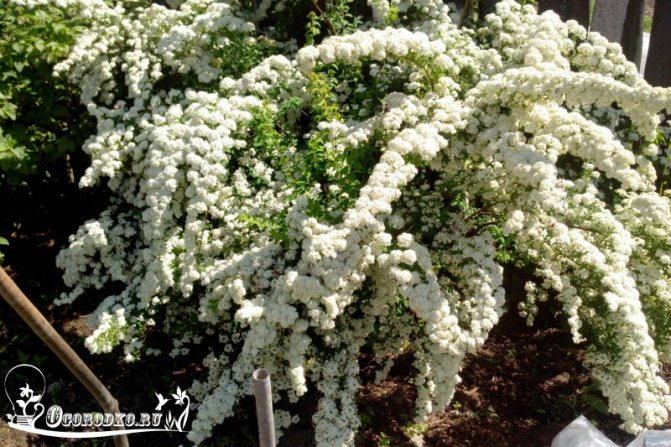

in the photo - spirea
It is necessary to fertilize the spirea only if necessary, the shrub grows well without additional fertilizing. Usually, nutrition is given in early spring, using a mineral fertilizer with a nitrogen content. In the fall, only phosphorus-potassium fertilizers are applied so that the plant gains strength for wintering. Nitrogen fertilizers and mullein should not be applied starting from August, so as not to cause the growth of young shoots.
Caring for the spirea, many gardeners carry out pruning not only to give an aesthetic appearance, but also for the purpose of sanitation, removing weakened, dry, broken branches. Although the plant is rarely infested with pests or more, sanitation is necessary once a year. Spirea pruning is carried out in autumn or spring. It is advisable to cut adult powerful bushes in the autumn, so that the flowering is more abundant in the spring. Young seedlings, as a rule, do not need to be cut in the winter; it is better to do this in the spring, when it will be seen how the plant has overwintered (the frozen shoots are removed).
Reproduction of spirea is quite easy, it can be bred by cuttings, layering or seeds (with the exception of hybrid varieties). We decided to grow a spirea from seeds, then take the usual varieties (not hybrids). You will need a container, box, other container in which peat is placed, well moistened. Seeds are sown, covered with foil, planting is placed in a warm place. When the seedlings grow a little, they make a pick. They are planted in open ground when the threat of frost has passed, mulch and monitor irrigation. Spirea grown from seeds will begin to bloom no earlier than 2-3 years later.
Spirea can be propagated by cuttings green or lignified. Cuttings are carried out in the month of June. Take a good pruner with a sharp blade and cut off the young shoots at the base (in the root zone). Leaves can be left, and the bark can be scratched with pruning shears, so the formation of roots will begin faster. Cuttings are buried in the ground to the beginning of the growth of leaves, be sure to watered.
Reproduction by layering is carried out in the spring with the appearance of the first leaves. The healthy young and bending shoot they like is bent to the ground, fixed with iron brackets and covered with earth, regularly watered. The division of the spirea bush must be carried out with a sharp shovel, in early spring, carefully cutting off the necessary part, which then needs to be transplanted to a new place.
Spirea. Care
Despite all their external attractiveness, spireas are quite unpretentious and grow and bloom well under the most ordinary conditions - loose fertile soil, good illumination, no stagnant water, 3-time fertilizing per season with a complex of mineral fertilizers and a winter shelter for young specimens or for especially delicate varieties. The only subtlety when growing spirea is proper pruning.
- Spring-flowering spireas practically do not need pruning, with the exception of sanitary, when old (over 5 years old) shoots, dry and broken branches, shoots frozen over the winter are removed. Pruning is carried out immediately after flowering, but it is not necessary to shorten the faded shoots, as this will cause increased growth of lateral branches, at the ends of which the inflorescences will be small and expressionless.And most importantly, the shape of the bush will be disturbed and the effect of drooping flowering branches to the very ground will be spoiled.
- Summer-flowering spireas are pruned in early spring, starting from the fourth year of life and at a height of 20-30 cm from the ground. If this is not done, then gradually the bush will lose its shape, as the old branches begin to deviate from the center of the bush, laying on the ground. And if you cut only at the tops, then the plant will give thinned young shoots with small unattractive inflorescences. If, nevertheless, there is a fear of short pruning, then as an experiment you can cut exactly half of the bush, and leave the other half alone - and in the middle of summer it will be possible to compare the results.
Healing properties
Willow spirea is endowed with a whole range of medicinal properties in its chemical composition.
- Ascorbic acid helps to improve immunity and strengthen the walls of blood vessels.
- Carotenoids are able to stop the aging of cells in the body.
- Salicylic acid essential oil. It has analgesic and antipyretic properties.
- Flavonoids, activate metabolic processes in the body.
- Tannins.
In folk medicine, the shrub is used as infusions and decoctions. It is used for gastrointestinal upset, one tablespoon several times a day. Also, the broth helps with colds.
Preparing a place for a spirea
Preparation for planting this shrub consists in drawing up a site plan. You need to correctly distribute plants throughout the territory in order to choose the right place for meadowsweet. Regardless of the variety, these shrubs feel great in sunny glades and in a small shade. In the sun, they give more flowers, but in the shade, the color of the discarded brushes will be more intense, and they will last longer on the branches.
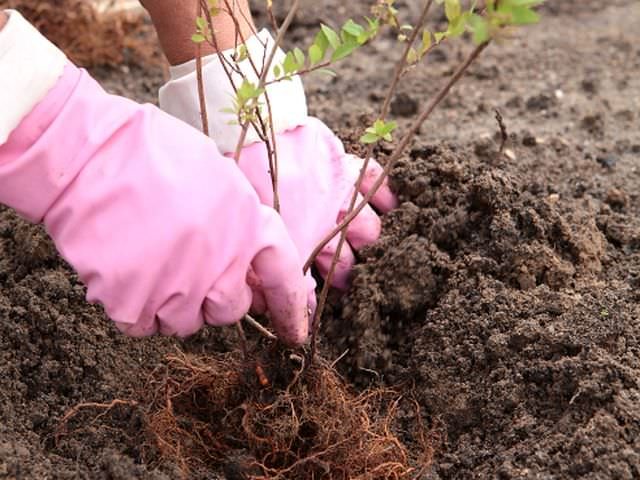

It is best to place the plant in an area with watertight soil and moderate moisture. With sod or leafy soil, you can make the right type of soil yourself. Peat and sand need to be added to clay soil, and some varieties of spirea cannot stand calcareous soils, for example, this feature is characteristic of Billard.
Important! Like all other plants, meadowsweet survival is much better if planted on a cloudy day. Otherwise, she will be ill for a long time.
Suitable varieties
Spirea has a large number of varieties, and many of these shrubs can be grown in Siberia. The plant can be conditionally divided, depending on the timing of flowering, into spring and summer. The most common ones are presented below.
Gray
One of the most popular varieties is hybrid. Obtained by crossing St. John's wort and grayish-white spirea. The shrub has white flowers with a gray tinge, forming bouquets, distributed along the entire length of the sprout. Blooms throughout the month, starting in mid-May.
The plant is sprawling, growing up to 2 meters. Crown formation occurs from spreading shoots. The leaf plates are oblong, have a deep emerald color. The lower part of the leaf plate is grayish.
Spirea Grefsheim is recognized as a striking representative of this hybrid. Differs in an original lush appearance, characterized by increased winter hardiness. Blooms in the second year after planting. The period lasts from 35 to 45 days. Double flowers, small, 10 mm in diameter, collected in bouquets.
Wangutta
Another representative of the hybrid. It is characterized by increased frost resistance. Representative of large bushes, height and scope can reach 2 meters in size.
Shrub formation occurs due to spreading branches, which are abundantly covered with jagged foliage. Leaf color: top - green, lower part - bluish. Small flowers, up to 60 mm, create bouquets distributed across all branches. Blooms by mid-June. Some shrub varieties repeat flowering in August.
Features of growing spirea in Siberia
Most shrub varieties tolerate frost well, so they are often grown in Siberia and other northern regions. The plant is unpretentious and blooms profusely with proper care. All she needs is proper watering, fertile land and plenty of sunshine.
Planted shrubs in the fall, cover for the winter. Prune the plant in the off-season.
Planting in the spring is carried out only after the soil has warmed up sufficiently. In autumn, it is advisable to have time to do this before October.
For planting spireas in Siberia, they choose a place well-lit by the sun. Thanks to this, the plant will actively grow, bloom and bear fruit luxuriantly.
Description of varieties
In total, there are about 100 species of this shrub. The plant is unpretentious, but requires planting in high-quality, fertile soil. Some species are frost-resistant and drought-resistant.
Depending on the species, spireas can be very different, they have different shapes and shades, some may even change their color as the season changes. There are spring and summer spireas. The spring species blooms much less in time.
The flowering time of the summer spirea is longer, and the flowering is more abundant. The plant begins to bloom in the third year of life. Moreover, the first flowering will be rather scarce - it may be just a few flowers. Spring spireas bloom, as a rule, in all shades of white.... Spring shrub is distinguished by its splendor.
Summer spireas bloom, respectively, in summer. Inflorescences bloom at the tips of the branches. The shrub is used for various purposes: in landscape designs, in parks, in hedges, even for medicinal purposes.
The brightest representatives of the type of spire:
- spirea willow;
- billard;
- douglas;
- Hypericum.
Each type of shrub is beautiful in its own way and has its own individual characteristics.
Appearance
Spireas can spread along the ground, can be lying, spreading and erect. Shades can be completely different. The bark on the bush may flake off. The root system is usually lumpy.
The leaves of the plant can be of different shapes - from willow to rounded. They are located alternately one after another.
Small flowers, gather in large inflorescences. Inflorescences can be located at the ends of branches or along the entire length of the shoot. You can propagate a shrub in 4 ways:
- layering;
- cuttings;
- seeds;
- dividing the bush.
Reproduction is easy, without any difficulty..
Spirea wavy
This representative of meadowsweet prefers moist soil, so in nature it prefers to grow in swampy places or at river estuaries.
The plant is a tall, about 2 meters in height, upright shrub. The leaves of the plant have sharp tips, green, not very large. The flowers are pale pink, collected in inflorescences. Each inflorescence is approximately 15-20 cm long. These are lush, frost-hardy, viable plants. Willow spirea is one of the few plants with 100 percent seed germination. Survives well in urban environments. Does not react at all to atmospheric pollution with exhaust gases and smoke.
It begins to bloom around the end of spring, flowering continues until mid-summer. Often, the plant can bloom again, but the flowering will no longer be so abundant. Willow spirea feels comfortable in the climatic conditions of the middle zone.
Billard variety
As a rule, both experienced gardeners and beginners choose the most spectacular types of meadowsweet for planting. This type includes billard's spirea. The plant in nature prefers to grow in mountainous or steppe areas.
This species has various shapes and shades. Its shape can be round, cascading or pyramidal.
Foliage tends to change its color. It can be green or silver.In the autumn season, the bush changes the color of the foliage and acquires yellow, violet and purple leaf colors.
Flowering meadowsweet of this species, in comparison with other representatives, is long. It blooms with small flowers, which are collected in lush inflorescences. The flower can be from white to lilac and crimson. Like all meadowsweet, billard's spirea is divided into spring and summer. The plant tolerates frost perfectly, so almost all northern gardeners like to grow it in their garden.
Meadowsweet is completely unpretentious, it does not require any additional care. Spring pruning is the only maintenance condition.
Douglas species characteristics
An ornamental shrub belonging to the pink family can be found in nature in the desert, mountains, forests and forest-steppes.
The shrub grows up to 1.5 m in height, grows up to 2 m in width, upright, its shoots are red-brown in color. Leaves are oblong, lacent, up to 3-10 cm in length, silvery.
The shrub blooms with small pink flowers, which gather in small pyramidal inflorescences located throughout the shoot. The inflorescences cover the entire bush. Bloom lasts 45 days from July to September. The flower grows and develops well and quickly. Frost-resistant and unpretentious. After flowering, the plant begins to bear fruit. The meadowsweet begins to bloom in 3-4 years.
Meadowsweet is widely used for decorative purposes. It can be seen in landscape designs, more often in personal plots, in addition, it perfectly takes root in private pools or artificial fountains. It is planted on the edge of the reservoir, and thus the effect of natural beauty is created. Planting and care is no different from other plants of this species. The care requirements are the same as for other meadowsweet.
Spirea ashy or St. John's worm
Spirea St. John's wort is a decorative hybrid. Its second name is ash. During its flowering, the shrub is simply beautiful. The buds of this species of meadowsweet begin to form in the fall, so pruning is done immediately after flowering. In nature, it can be found in forest-steppes and steppes. The shrub can reach a height of 2 m. Its foliage is grayish. After 10-15 years, meadowsweet need to be rejuvenated. This can be done by cutting off all shoots to a hemp state.
Representatives of this species are frost-resistant, love the sun or partial shade, do not succumb to drought. The plant is pruned, grows quickly, not whimsically. The meadowsweet blooms with small white flowers, which gather in small inflorescences located along the entire branch of the plant.
Reproduction
The plant is propagated in several ways:
This method is considered the easiest and fastest. With the help of it, it is possible to get a large number of shrubs at once. No special seed preparation is required.
Twigs with seed pods are harvested in August. They should not be open and have a dark brown tint. After a couple of weeks, the pods are opened and the seeds are harvested for sowing. First, they are planted in boxes with special soil containing vermiculite and peat. Further, when sprouts appear, they are already planted in the garden.
With this method, all varietal qualities are successfully preserved. However, more effort will have to be made here.
Reproduction begins in July and predominantly annual shoots are selected, which grow strictly vertically. Further, cuttings are cut from them, leaving four or five leaves on each. For half a day, the cuttings are soaked in a rooting solution with water in a ratio of 2 liters to 1 milliliter. For root formation, fertilize with a powder stimulant. Cuttings are planted in moistened sand at an angle of forty-five degrees.
The cuttings are left in a dark place, protected from drafts. Cover with foil and spray regularly before the onset of cold weather. For the winter period, the pot is covered.With the arrival of spring, they are planted in open ground.
You can find out more information about willow spirea in the video link below.
The whole process of caring for a plant mainly consists of constant watering, fertilizing and pruning bushes.
Willow spirea requires timely and moderate watering. In a drought, one bush receives about 15 liters of water per week.
The best time for fertilization is the spring period, namely the time before the flowering of the shrub. A bucket of manure and five buckets of water are used as top dressing. Ten grams of superphosphates are added to the bucket of the mixture.
Pruning is useful for both ornamental quality and to improve the quality of the plant's flowering. Pruning is done with the arrival of spring so that the plant has time to recover before the flowering season.
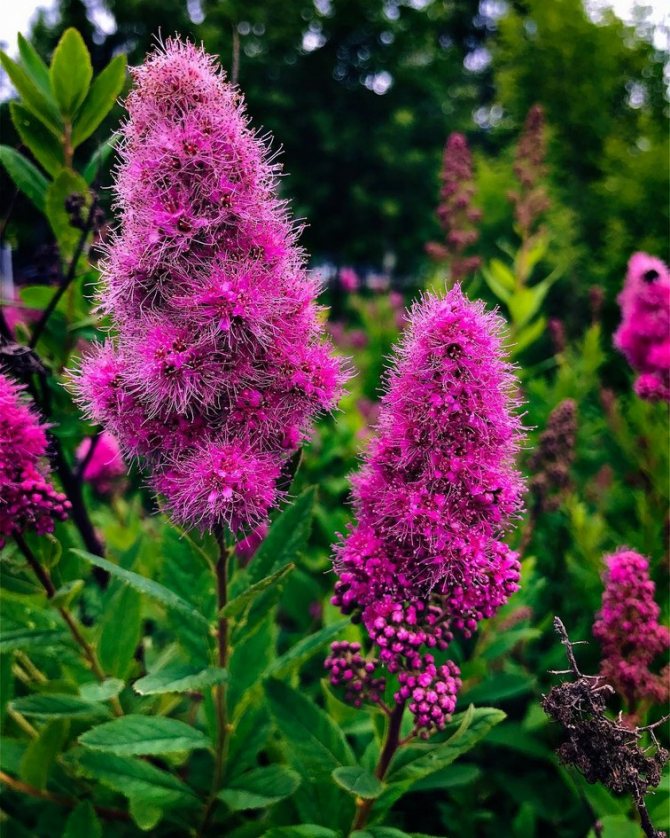

Care
This shrub does not require special care. But if it is timely watered, fed and pruned, then the grateful spirea will present it with a chic shock of amazingly beautiful inflorescences.
Watering
Meadowsweet is a drought-resistant plant. It can survive in extreme conditions, but that doesn't mean it shouldn't be watered. During a hot and dry summer, the bush will certainly suffer from thirst. Especially young plants need regular watering.
Spirea roots are close to the soil surface and require regular moisture. For an adult individual, you need 15-20 liters of water twice a month. For individuals lower - 10-15 liters. The soil must be loosened and mulched, weeds removed.
Botanical characteristics
Spirea is a deciduous perennial plant with a height of 0.15-2.5 m. It is fed by a fibrous surface rhizome. Shoots grow straight, spread on the ground or rise. Over time, even erect branches bend under their own weight. The color of the branches is light brown or dark brown. The bark exfoliates in longitudinal plates.
The successive short-petiolate leaves do not have stipules and are distinguished by a narrow-lanceolate shape with a distinct relief pattern of the central and lateral veins. The edges of the foliage are serrated or serrated. The color can be very varied. Some plants are covered with green leaves throughout the season, while the foliage of others changes several times from red to yellow, green or orange.
The first weak flowering begins from the second or third year of the spirea's life. In mid-spring or already in summer, many umbellate or paniculate inflorescences bloom in the leaf axils. Small corollas, 6-10 mm in diameter, closely spaced, have a disc-like shape. Flowers with five separate rounded petals and a lush core (up to 60 stamens and about 5 ovaries) can be painted white or pink.
After pollination, lanceolate flat brown seeds ripen in multi-seeded leaflets. Their length is only 1.5-2 mm. Ripe fruits crack at the seams on their own.
Features and morphological description of spirea
Spirea is a valuable ornamental shrub that is often chosen by gardeners and landscape designers to decorate their backyards. This is due primarily to the versatility of the plant, with its excellent winter hardiness, splendor of flowering and good adaptation to new conditions. It is these qualities that make a spirea of any kind an excellent solution in landscaping not only in the central part of Russia, but also in Siberia and the Urals.
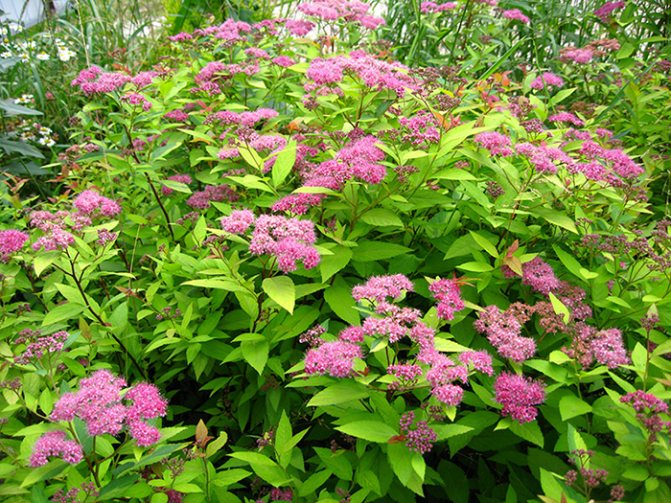

Spirea or meadowsweet is a genus of ornamental deciduous shrubs that belong to the Pink or Rosaceae family. Today this plant is widespread, lush bushes of spirea can be found on almost any continent. The habitat of deciduous shrubs is considered to be the northern hemisphere with all climatic zones.In total, about 90 species of spirea can be counted in culture, which, in turn, include a huge number of varieties.
The scientific name of the flowering shrub "spirea" comes from the ancient Greek word "speira", which means "bend" in translation. There is nothing surprising here, since the branches and shoots of the spirea are flexible, and during flowering, the shoots completely covered with flowers bend like arches, giving the plant a spectacular appearance. In addition, there are other names among the people that perfectly characterize this bush. The most popular popular name is "bride", which is associated with the moment of flowering shrub in spring, when the shoots are completely covered with small white flowers. The whole plant at this time resembles a delicate wedding lace. However, only spring-flowering varieties of spirea are similar to a wedding dress. Plants that bloom in summer boast vertical inflorescences in pink, red and white.
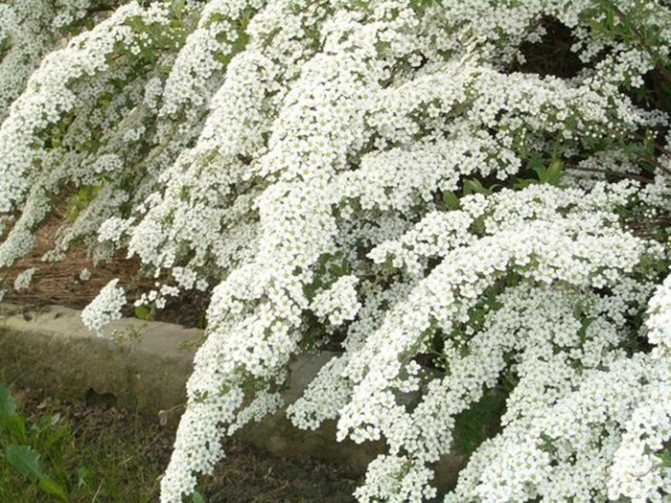

Spirea description:
- Spirea is a medium-sized ornamental deciduous shrub that is very popular with both professional designers and ordinary amateurs and connoisseurs of bright and unusual plants.
- The root system of the plant is fibrous and located in the upper layer of the soil, and therefore you need to be careful when loosening the soil around the bush.
- Spirea shrubs can be both dwarf and tall. On average, the height of a plant can be from 15 cm to 2.5 meters, which will allow a gardener to choose the best variety for planting in Siberia.
- The shrub itself is formed by creeping or spreading branches, erect or recumbent shoots. Branches can be light brown or dark in color.
- The branches of the spirea have a distinctive feature - the bark tends to flake longitudinally.
- The shape of the crown of a plant can also be different, it all depends on the specific type and variety of spirea. You can find a plant with a spherical crown shape, with a pyramidal, weeping, creeping and erect.
- The shape and shade of the foliage of the spirea can also differ and vary depending on the particular variety. The leaf plate can be three-lobed or five-lobed, lanceolate or round. The color of the foliage is light green to dark green.
- The leaves on the shrub are attached to the petioles, they are arranged alternately.
- In autumn, depending on the variety, the leaves can be painted in a variety of shades: yellow, orange, red, brown, burgundy.
- The most important dignity and decorative value of the spirea is the flowers that appear on the plant in large numbers.
- The flowers are small, but they bloom on almost all shoots and branches, thereby forming inflorescences of various shapes: paniculate, spike-shaped, corymbose, pyramidal. There are also single-flowered spirea varieties.
- The color of the inflorescences is not diverse; varieties with white and cream flowers are most often found. The summer-flowering varieties are also characterized by pink flowers, crimson and reddish.
- It differs in different types of spirea and the location of the inflorescences. In some, they are located along the entire length of the shoot, while in others, flowers bloom only at the tops.
- Most varieties of this culture are winter hardiness, so they can grow well in Siberia. In addition, the shrubs have established themselves as excellent city dwellers - they are not hindered by the strong gas pollution of the air.
- Spireas can boast of unpretentious care and quick and painless adaptation to new growing conditions, for which this plant is valued among gardeners.
- Due to the huge number of shrub forms, inflorescence colors and flowering time, spirea bushes can be used for a wide variety of garden compositions: they look good in single plantings, in group, in mixed ones.


Reproduction
Reproduction of gray spirea can be done in two ways: by planting seeds or by cuttings.
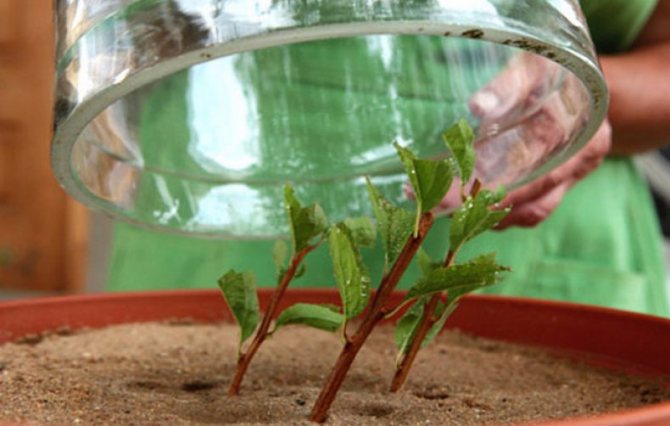

The first method is simpler and does not require any troublesome measures. First, you need to collect the seed boxes from the bush, while they are not yet open and do not have a brown color. It is better to do this at the end of summer.
Literally in two weeks, the boxes ripen and open. The resulting seeds do not require additional processing and are already ready for planting. Previously, it is better to place the seeds in a special soil distributed among the boxes for three months.
Propagation by cuttings gives a slightly higher percentage of success with survival, but also requires more effort. It should start in mid-summer or early autumn. Young shoots no more than a year old, growing almost vertically upwards, are best suited for propagation.
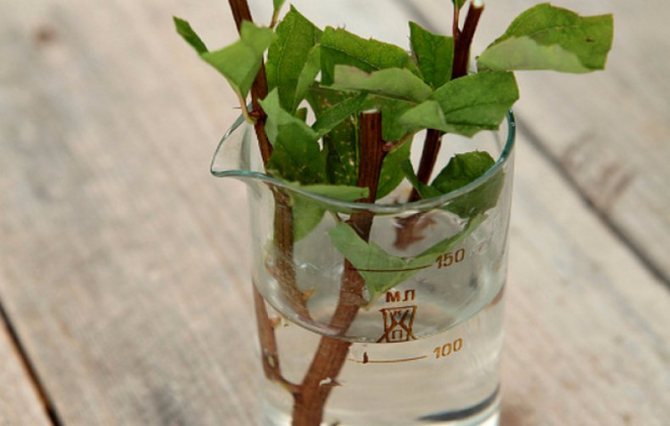

They need to be cut off, leaving about five leaves on each cutting. The resulting cuttings should be soaked overnight in a special solution of "Epin" in a ratio of one milliliter to two liters of water. Next, the cuttings are planted in wet sand at an acute angle.
After that, they should be covered with foil or glass cover and sprayed regularly. Young seedlings should be in a shady place. For the winter, it is required to sprinkle it with fallen leaves, and then plant it in the spring when the first shoots appear.
Read also: Cabernet Sauvignon grape variety: description, advantages and disadvantages
Gray spirea is quite undemanding in its care. It consists in regular watering, feeding and periodic pruning of the bush.
Willow spirea requires moderate watering. It is necessary to increase its volume only during the dry season. At this time, each bush needs about fifteen liters of water per week.
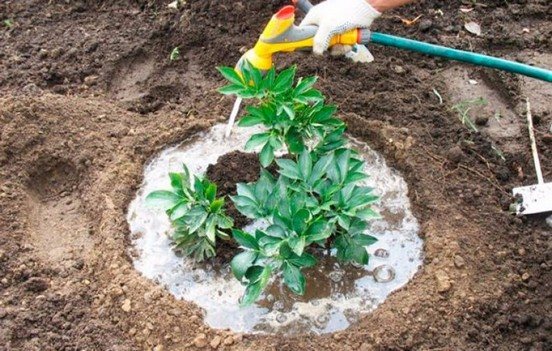

The best time to fertilize a plant is spring, before the spirea begins to bloom. This requires mixing a bucket of manure in five buckets of water. In each bucket of the resulting mixture, you will need to add from five to ten grams of superphosphates.
To prevent weeds, the soil around the shrub should be mulched with humus, peat, or wood shavings.
Regular pruning of the branches of the gray spirea is required not only to care for the appearance of the crown, but also for better flowering of the shrub. Pruning should be done in early spring so that the plant has time to recover before summer flowering.
How to choose and prepare a seedling correctly?
Important! Buy seedlings only from specialized garden centers or nurseries. In this case, you will definitely get what you want.
The first thing to look for when choosing a seedling for planting is the root system. It should be closed, with an earthen lump. Otherwise, the roots may dry out or be damaged during transportation and planting. If the roots are open, then check the lobes - they should be elastic, moist, without blackness on the cuts and breaks. Next, pay attention to the shoots.
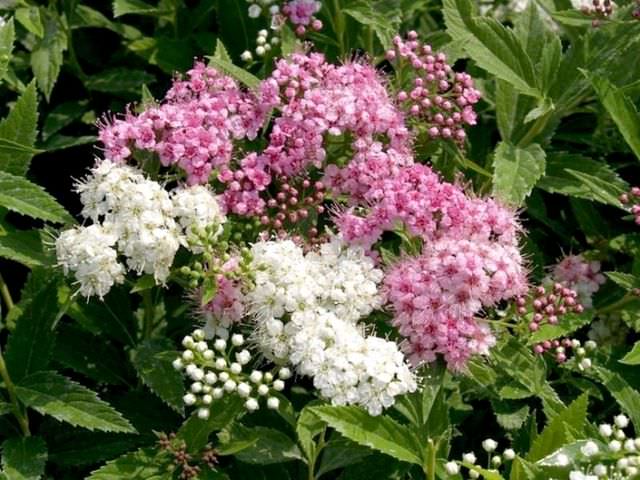

They should not have already blossomed leaves, since such plants are very difficult to tolerate transplanting. Plants with widely spread branches are not worth buying. At the same time, a small number of branches of the second order, on the contrary, is a good sign.
Examine the kidneys and bark. These parts should have a healthy appearance, a good seedling has a light green bark. If the shrub is in a pot, inspect the drainage holes. If thin roots are visible from them, then it is worth walking past such a specimen - this means that the shrub has been sitting in a pot for more than a day and the container has become cramped for it - an earthen lump in this case is covered with roots entirely. In the process of transplanting, the roots may be damaged, and the meadowsweet will not take root or will hurt for a very long time.
How to grow a shrub?
Shrub cultivation is not difficult. The success of the plant development depends on the correct preparatory work and the implementation of the planting procedure.It is the correct fit that is the key to success. Therefore, it is important to buy high-quality seedlings, choose a place.
The choice of planting material
An important point is the acquisition of healthy planting material that meets all quality requirements, as well as the choice of exactly those species that are suitable for a given region. Spirea is recognized as a hardy and frost-resistant shrub, so almost all varieties are able to adapt in Siberia.
- recommended to purchase at specialized points of sale;
- visual inspection of the bush is important: during spring planting, there should be no swollen buds or emerging leaves, and during autumn planting, the shrub should shed its foliage;
- view the roots (if they are open): the roots should be firm, without signs of mold, small damage increases the chance of infection;
- when buying shrubs in containers, the spirea sits at any time.
Soil preparation and site
The selection of the most favorable site and preparation of the soil that meets the requirements is the key to the full development of the shrub.
Despite the fact that the plant is considered unpretentious, it is necessary to create conditions for quick adaptation and abundant flowering. Accordingly, it is recommended to choose a sunny area, planting in a shaded place reduces the decorative qualities of the shrub. It is undesirable to plant in lowlands, especially where moisture and cold accumulate.
The culture has a sufficiently developed root system, therefore, it is undesirable to plant next to fruit bushes and trees. Spirea needs a light, enriched soil that is easily permeable to oxygen. When planting in spring, it is important to prepare the soil in the fall, apply the necessary fertilizers.
What is the difference from the spirea Graciosa and from the Japanese spirea?
There are many varieties of this beautiful ornamental shrub, so it is difficult for novice gardeners to choose one among the variety. The most popular, in addition to those described above, are the Graciosa and Japanese varieties..
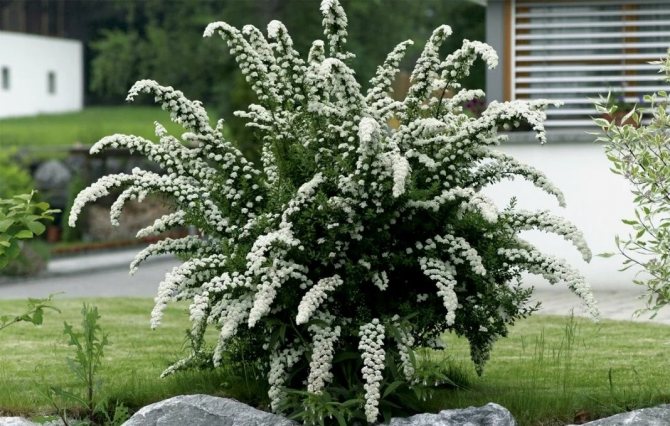

According to the description, they have a number of differences from Grafsheim:
| Branches | The shoots of the Japanese spirea have a felt edge, which gradually disappears with age. |
| Leaves | During blooming, they are reddish, after their surface becomes green, and the back side has a bluish tint. In autumn, the leaves turn red and yellow. The shape of the leaves does not differ from Grafsheim, but their size ranges from 2.5 to 7 cm. Graciosa is distinguished by green leaves on both sides, which turn yellow in autumn. |
| Flowers | Japanese spirea is distinguished by corymbose-paniculate inflorescences of pink with a red tint. Graciosa has umbellate white inflorescences. |
| Flowering period and duration | Japanese spirea begins to bloom in late July - early August, which lasts up to one and a half months. Graciosa blooms in late spring (May) or early summer, flowering duration is about 3 weeks. |
Is it possible to grow spirea in the Urals
The climatic conditions in the Urals are different in different regions: the average winter temperature in the north is minus 22 degrees, in the south - minus 16 degrees. Summer rates for the northern regions are + 8, for the southern regions + 20 degrees. The polar regions of the Urals are characterized by long (up to eight months) and cold winters, alas, short summers; in the south, it lasts up to five months. If we talk about spirea, planting and care in the Urals, then it is possible to grow it here, preferably in the southern regions. The flora of the Urals is very diverse, in the west and south such thermophilic plants grow as oak, beech, hornbeam, linden, maple, mountain ash, hazel, fragrant violet, shoes, honeysuckle, currants, hemlock. Winter-hardy varieties of spirea in the Urals will take root, will grow and reproduce well.
What varieties are suitable for growing spirea in the Urals
Consider the most winter-hardy and frost-hardy types of spirea.
Spirea gray
- a spreading shrub of two meters in height with strong ribbed stems.The upper surface of the leaves is gray-green, paler below, the shape of the leaves is sharp at both ends. Inflorescences are thyroid, loose, white flowers. The species blooms in May, bears fruit in June.
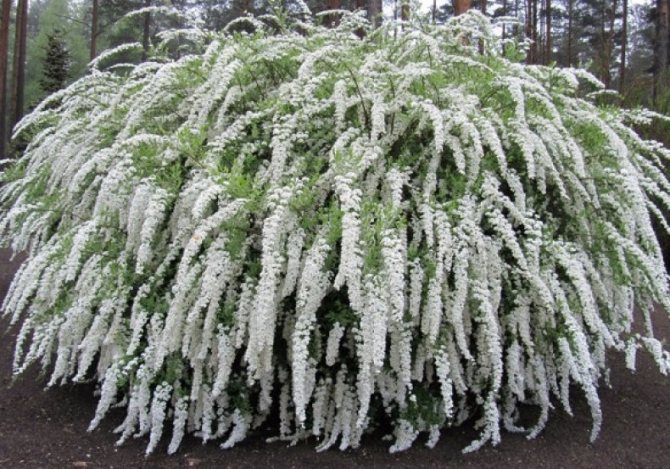

Spirea Wanguta
- a two-meter shrub, a cascading crown shape, a diameter of two meters. Stems are flexible, thin, drooping. Leaves are not pubescent, length up to 3.5 cm, oval shape with a serrated edge. Flowering begins in the third year of life, the flowers are white, it is noteworthy that re-flowering is possible in August. Shades tolerant, winter-hardy, grows quickly. The preferred reproduction for this type of spirea is by cuttings. Looks great near water bodies, among conifers, along the edge of large flower plantings.
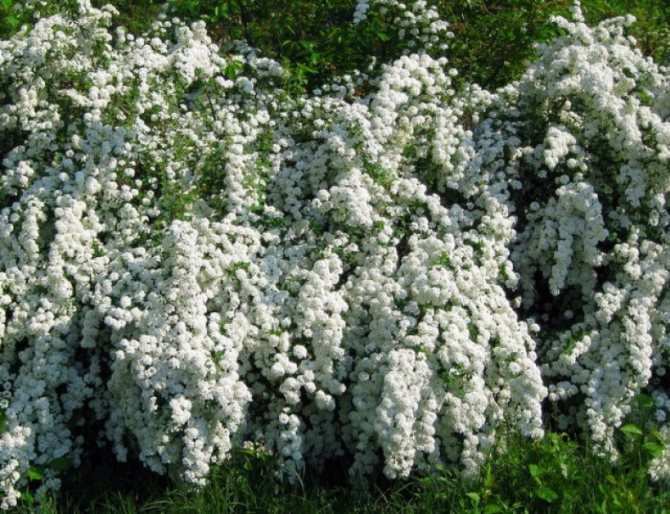

Spirea oak-leaved
- common in Eastern European territories, in the Far East. Feels great on rocky soils. The bush grows up to two meters, the stems are flexible, gently hanging down, forming a hemispherical crown. Leaves are oval-oblong, with a serrated edge, the length of the plate is 5 cm. It blooms in May in a creamy color, the duration of flowering is 30 days. Decorative in autumn: foliage becomes golden yellow. Pruning spirea in autumn is well tolerated and stimulates the growth of new, stronger shoots.
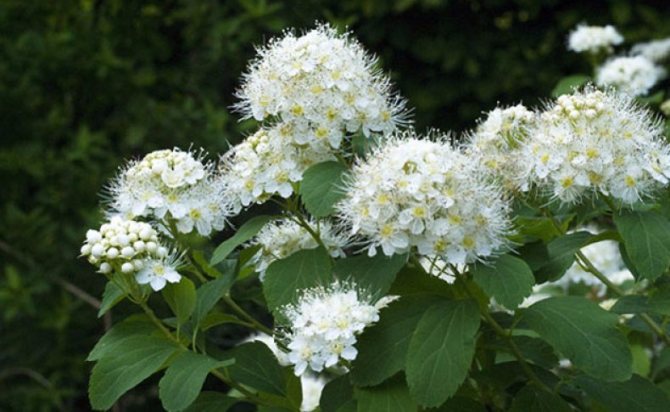

Spirea average
- a lush shrub, distinguished by bright green foliage, the shape of the crown is spherical. Blooms in May with snow-white flowers forming thyroid inflorescences. Easily adapts after transplantation, propagates by root suckers. Frost-resistant, not afraid of shade. Fruiting in the third year of life. Under natural conditions, it grows in Siberia, the Far East and Central Asia.
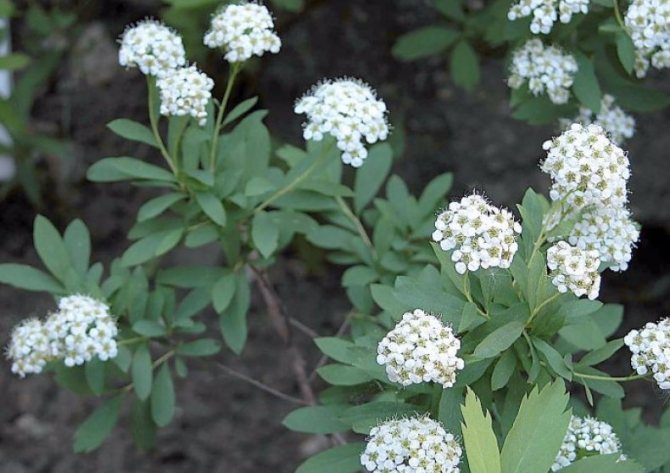

Spirea birch-leaved
distributed in Korea, Japan, Siberia and the Far East. It is named so for the similarity of the shape of the foliage to the birch. This species is short - only 60 cm in height. Green leaves turn yellow in autumn, standing out in the area with a bright golden ball due to the rounded shape of the crown. The plant blooms in June, the first flowering occurs in the fourth year. White or pale pink flowers are collected in thyroid inflorescences. Hardy, does without shelter for the winter.
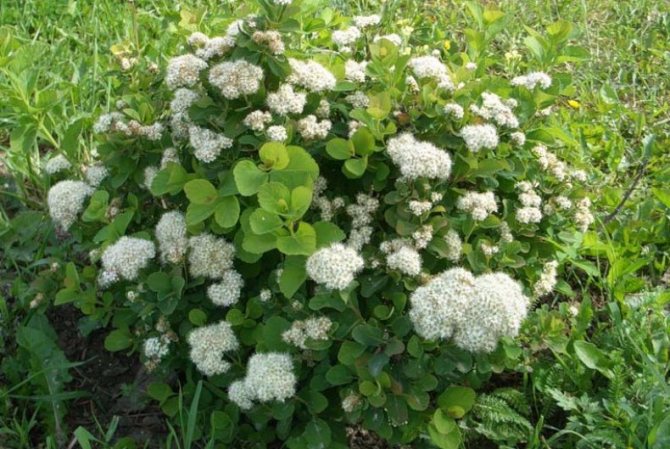

Spirea Billard
distributed from Arkhangelsk to the steppes of Central Asia and the Caucasus. Two-meter shrub with large leaves up to 10 cm long. The leaves are fleecy to the touch, gray-green in color. Blooms with bright pink flowers, collected in dense pyramidal inflorescences. Long bloom - from June to the first frost. Does not bear fruit, propagates by cuttings. Shade tolerates well.
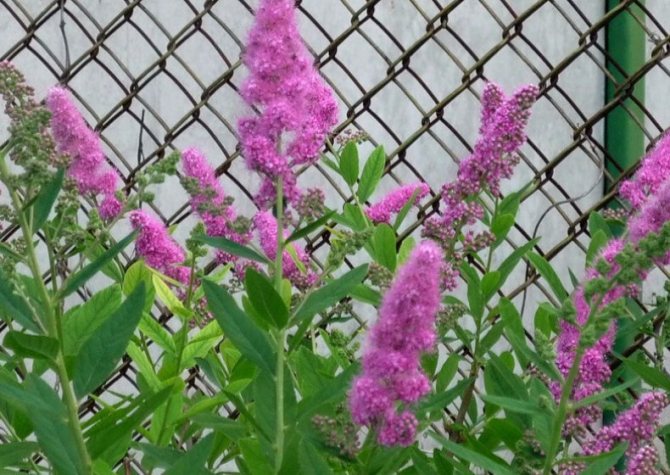

Pruning
The pruning technique is different for summer and spring varieties. The former are pruned in the spring immediately after flowering, the latter - in the fall. In the first years of life, the plant does not need pruning, you need to let it build up its vegetative mass and root system. It is enough to remove in the spring frostbitten, damaged or dried out shoots, as well as those that spoil the overall shape of the bush. From the age of 7, pruning becomes mandatory.
To do this, remove all old shoots, leaving 5 pieces of young for flowering next year. The same operation is done a year later, gradually renewing the bush. The average life span of a spirea is 20 years. After 14 years of age, pruning should be either radical rejuvenating, or very gentle, because you should not wait for abundant flowering anyway. As for the formative pruning, it should be done exclusively in the spring, so as not to weaken the bush in the winter.
In Siberia, flowering shrubs of spirea can often be found. This plant perfectly tolerates severe frosts and severe winters. However, when choosing a spirea for planting in Siberia, you should pay attention to the varieties. Some of them are quite thermophilic. Observing all the rules for planting and caring for spirea in Siberia, you can grow a beautiful plant.

